IoT Operating System Based Fuzzy Inference System for Home Energy Management System in Smart Buildings
Abstract
1. Introduction
2. Related Work
2.1. Nature-Based Algorithms for DSM
2.2. Fuzzy Inference System for DSM
3. Problem Formulation
3.1. Fuzzy Logic Controller
3.2. The Proposed Model
- (i)
- A system that helps the user to set a wide range of the thermostat set-points based on the temperature and relative humidity.
- (ii)
- An energy management controller that will help in better energy optimization.
- (iii)
- A controller that can handle smart grid initiatives like ToU and DR that results in the energy management and conservation.
- (iv)
- The proposed controller will help in initializing the thermostat set-points that maintain the temperature under user comfort zone.
- (v)
- FIS controller is designed in such a way that can include other parameters without having the hassle to define a large number of rules.
- (vi)
- The proposed controller includes room temperature variation that helps in making better decisions for the energy conservation.
- (vii)
- Using an IoT based fuzzy controller will result in real-time monitoring and total controllability.
3.3. Model of Residential Heating System
- Heater:Heater component is modeled using the amount of heat gain supplied to the room. When the heater is ON, hot air is blown at a constant temperature and a flow rate . Heat gain inside the room is calculated using the equation below. Output of the heat is dependent on the thermostat control signal:where is heat gain because of hot air flow from heater, is temperature of hot air from heater, is room air temperature at real time, is air mass flow rate through heater, and is heat capacity of air at constant pressure.
- Thermostat:Thermostat in the room calculates the difference in the initialized thermostat value and room temperature and turns the heater ON or OFF based on the difference. Thermostat computes the difference at each 5-min interval. The working of the thermostat can be summarized as follows:
- (i)
- When the room temperature is below the desired set-point, the heater state is ON and it supplies the heat gain and value of control signal is equal to 1.
- (ii)
- When the room temperature is above the initialized set-point for that particular time, the heater is turned OFF by the thermostat and heat gain is equal to zero as the control signal is 0.
- Room:In order to calculate the temperature variation, the system considers both the heat gain from the heater and heat loss from room to the surroundings. Heat loss () was calculated using the equation mentioned below where is outdoor temperature at real time and is equivalent thermal resistance of the house:
4. System Model Implementation
4.1. Outdoor Temperature
4.2. Indoor Temperature
4.3. Occupancy
4.4. Price Tariff
4.5. Relative Humidity
4.6. Initialized Set-Points
4.7. Automatic FIS Rule Base Generation
- (i)
- In worldwide adaptive thermostat [28], there were four variables with three membership functions and one variable with two membership functions. This resulted in a total of 162 rules to be defined in the rule base of Mamdani FIS and Sugeno FIS.
- (ii)
- Adding humidity as a parameter to the system results in five variables with three membership functions and one variable with two membership functions. A total of 486 rules are required to be defined for the both Mamdani FIS and Sugeno FIS.
- (i)
- The first step is the fuzzification process in which all the membership functions of the system parameters are initialized and defined.
- (ii)
- The second step is defining the rules in the rule base by giving weightage to membership functions of input parameters and then assigning the suitable output fuzzy value.
- (iii)
- The third step uses the Mamdani FIS and Sugeno FIS to evaluate the energy consumption.
- (iv)
- After rule evaluation, defuzzification is performed to get the crisp value for the energy consumption. In the end, calculation of remaining performance measures is performed.
| Algorithm 1 Automatic Rule Generator |
|
- (i)
- Temperature: Indoor temperature () and outdoor temperature () for both hot and cold cities have membership functions of (1) Low (L); (2) Medium (M); and (3) High (H) according to their cold and hot weather.
- (ii)
- Electricity Pricing: Pricing tariff () is classified into the following membership functions: (1) Off-Peak (OP); (2) Mid-Peak (MP); and (3) High-Peak (HP).
- (iii)
- Occupancy: The user can either be present in the residential building or not. This condition is demonstrated using the membership functions of (1) Absent (A) and Present (P).
- (iv)
- Thermostat set-points and Humidity: Both initialized set-points () and humidity () input parameters are classified in the membership function of (1) Low (L); (2) Medium (M); and (3) High (H).
- (v)
- Energy consumption: Output of the proposed FIS is energy consumed (), which is classified into the following membership functions: (1) Very Low (VL); (2) Low (L); (3) Medium (M); (4) High (H); and (5) Very High (VH).
5. Simulation Results
5.1. Results of FIS with Feedback
- 1
- Scenario I:In Scenario I, outdoor temperature represented the coldest day that is below 0 C. As the temperature is very low, it is likely to take more energy consumption to maintain the inside temperature according to the user desired thermostat set-point. Figure 9 represents the room temperature variation with respect to the initialized set-points, outdoor temperature, and the heater state.
- 2
- Scenario II:Outside temperature in this scenario depicted a sunny day where the outdoor temperature reached the desired thermostat temperature, in this case there was no need to turn ON the heater and the simulation results shown in Figure 14 depict the same behavior of the heater state in response to outdoor and indoor temperature. During the afternoon, outdoor temperature rises and the heater is kept in an OFF state in order to conserve the energy, as compared to the previous technique, where the heater is still ON and is utilizing the energy because the previous approach does not consider the variation in the room temperature.
5.2. Results of FIS with Humidity
- 1
- Energy consumption with proposed FLC in Hot Cities
- 2
- Energy consumption with proposed FLC in Cold Cities
- 3
- Total Cost incurred with proposed FLC in Hot Cities
- 4
- Total Cost incurred with proposed FLC in Cold Cities
- 5
- Results for PAR using proposed FIS
- 6
- User Comfort maintenance using proposed FIS
6. Conclusions
Author Contributions
Funding
Conflicts of Interest
References
- Energy Information Administration. Household Energy Consumption and Expenditures, Consumption by End Use; Energy Information Administration (EIA): Washington, DC, USA, 2010. [Google Scholar]
- Office of Energy Efficiency. Energy Efficiency Trends in Canada; Natural Resources of Canada: Ottawa, ON, USA, 2012. [Google Scholar]
- Conti, J.; Holtberg, P.; Beamon, J.; Schaal, A.; Sweetnam, G.; Kydes, A. Annual Energy Outlook with Projections to 2035; Report of U.S. Energy Information Administration (EIA); EIA: Washington, DC, USA, 2010. [Google Scholar]
- Ahmad, M.W.; Mourshed, M.; Yuce, B.; Rezgui, Y. Computational intelligence techniques for HVAC systems: A review. Build. Simul. 2016, 9, 359–398. [Google Scholar] [CrossRef]
- Borenstein, S.; Jaske, M.; Rosenfeld, A. Dynamic Pricing, Advanced Metering, and Demand Response in Electricity Markets; Center for the Study of Energy Markets, University of California: Berkeley, CA, USA, 2002. [Google Scholar]
- Rahimi, F.; Ipakchi, A. Demand response as a market resource under the smart grid paradigm. IEEE Trans. Smart Grid 2010, 1, 82–88. [Google Scholar] [CrossRef]
- Albadi, M.H.; El-Saadany, E. A summary of demand response in electricity markets. Electr. Power Syst. Res. 2008, 78, 1989–1996. [Google Scholar] [CrossRef]
- Silva, B.N.; Khan, M.; Han, K. Load Balancing Integrated Least Slack Time-Based Appliance Scheduling for Smart Home Energy Management. Sensors 2018, 18, 685. [Google Scholar] [CrossRef] [PubMed]
- Haiad, C.; Peterson, J.; Reeves, P.; Hirsch, J. Programmable Thermostats Installed into Residential Buildings: Predicting Energy Savings Using Occupant Behavior & Simulation; Southern California Edison: Rosemead, CA, USA, 2004. [Google Scholar]
- Chu, C.M.; Jong, T.L.; Huang, Y.W. A direct load control of air-conditioning loads with thermal comfort control. In Proceedings of the IEEE Power Engineering Society General Meeting, San Francisco, CA, USA, 16 June 2005; pp. 664–669. [Google Scholar]
- Beaudin, M.; Zareipour, H. Home energy management systems: A review of modelling and complexity. Renew. Sustain. Energy Rev. 2015, 45, 318–335. [Google Scholar] [CrossRef]
- Mohsenian-Rad, A.H.; Leon-Garcia, A. Optimal residential load control with price prediction in real-time electricity pricing environments. IEEE Trans. Smart Grid 2010, 1, 120–133. [Google Scholar] [CrossRef]
- Pedrasa, M.A.A.; Spooner, T.D.; MacGill, I.F. Coordinated scheduling of residential distributed energy resources to optimize smart home energy services. IEEE Trans. Smart Grid 2010, 1, 134–143. [Google Scholar] [CrossRef]
- Du, P.; Lu, N. Appliance commitment for household load scheduling. IEEE Trans. Smart Grid 2011, 2, 411–419. [Google Scholar] [CrossRef]
- Mohsenian-Rad, A.H.; Wong, V.W.; Jatskevich, J.; Schober, R. Optimal and autonomous incentive-based energy consumption scheduling algorithm for smart grid. In Proceedings of the Innovative Smart Grid Technologies (ISGT), Gothenburg, Sweden, 19–21 January 2010; pp. 1–6. [Google Scholar]
- Molderink, A.; Bakker, V.; Bosman, M.G.; Hurink, J.L.; Smit, G.J. Management and control of domestic smart grid technology. IEEE Trans. Smart Grid 2010, 1, 109–119. [Google Scholar] [CrossRef]
- Keshtkar, A.; Arzanpour, S. An adaptive fuzzy logic system for residential energy management in smart grid environments. Appl. Energy 2017, 186, 68–81. [Google Scholar] [CrossRef]
- Guerrero, J.M.; Vasquez, J.C.; Matas, J.; de Vicuna, L.G.; Castilla, M. Hierarchical Control of Droop-Controlled AC and DC Microgrids—A General Approach Toward Standardization. IEEE Trans. Ind. Electron. 2011, 58, 158–172. [Google Scholar] [CrossRef]
- Karavas, C.S.; Kyriakarakos, G.; Arvanitis, K.G.; Papadakis, G. A multi-agent decentralized energy management system based on distributed intelligence for the design and control of autonomous polygeneration microgrids. Energy Convers. Manag. 2015, 103, 166–179. [Google Scholar] [CrossRef]
- Karavas, C.S.; Arvanitis, K.; Papadakis, G. A Game Theory Approach to Multi-Agent Decentralized Energy Management of Autonomous Polygeneration Microgrids. Energies 2017, 10, 1756. [Google Scholar] [CrossRef]
- Kuznetsova, E.; Li, Y.F.; Ruiz, C.; Zio, E. An integrated framework of agent-based modelling and robust optimization for microgrid energy management. Appl. Energy 2014, 129, 70–88. [Google Scholar] [CrossRef]
- Siano, P.; Cecati, C.; Yu, H.; Kolbusz, J. Real Time Operation of Smart Grids via FCN Networks and Optimal Power Flow. IEEE Trans. Ind. Inf. 2012, 8, 944–952. [Google Scholar] [CrossRef]
- Faria, P.; Vale, Z.; Soares, J.; Ferreira, J. Demand Response Management in Power Systems Using Particle Swarm Optimization. IEEE Intell. Syst. 2013, 28, 43–51. [Google Scholar] [CrossRef]
- Chaouachi, A.; Kamel, R.M.; Andoulsi, R.; Nagasaka, K. Multiobjective Intelligent Energy Management for a Microgrid. IEEE Trans. Ind. Electron. 2013, 60, 1688–1699. [Google Scholar] [CrossRef]
- Shah, A.; Huang, D.; Chen, Y.; Kang, X.; Qin, N. Robust Sliding Mode Control of Air Handling Unit for Energy Efficiency Enhancement. Energies 2017, 10, 1815. [Google Scholar] [CrossRef]
- Godina, R.; Rodrigues, E.M.G.; Pouresmaeil, E.; Matias, J.C.O.; Catalão, J.P.S. Model Predictive Control Home Energy Management and Optimization Strategy with Demand Response. Appl. Sci. 2018, 8, 408. [Google Scholar] [CrossRef]
- Godina, R.; Rodrigues, E.M.G.; Pouresmaeil, E.; Catalão, J.P.S. Optimal residential model predictive control energy management performance with PV microgeneration. Comput. Oper. Res. 2018, 96, 143–156. [Google Scholar] [CrossRef]
- Javaid, S.; Javaid, N.; Iqbal, S.; Mughal, M.J. Controlling energy consumption with the world-wide adaptive thermostat using fuzzy inference system in smart grid. In Proceedings of the International Conference on Information and Communication Technology Convergence (ICTC), Jeju, Korea, 18–20 October 2017; pp. 66–71. [Google Scholar]
- Javaid, N.; Ahmed, A.; Iqbal, S.I.; Ashraf, M. Day Ahead Real Time Pricing and Critical Peak Pricing Based Power Scheduling for Smart Homes with Different Duty Cycles. Energies 2018, 11, 1464. [Google Scholar] [CrossRef]
- Rasheed, M.B.; Javaid, N.; Ahmad, A.; Khan, Z.A.; Qasim, U.; Alrajeh, N. An efficient power scheduling scheme for residential load management in smart homes. Appl. Sci. 2015, 5, 1134–1163. [Google Scholar] [CrossRef]
- Mahapatra, C.; Moharana, A.K.; Leung, V.C.M. Energy Management in Smart Cities Based on Internet of Things: Peak Demand Reduction and Energy Savings. Sensors 2017, 17, 2812. [Google Scholar] [CrossRef] [PubMed]
- Yan, C.; Xue, X.; Wang, S.; Cui, B. A novel air-conditioning system for proactive power demand response to smart grid. Energy Convers. Manag. 2015, 102, 239–246. [Google Scholar] [CrossRef]
- Yun, J.; Won, K.H. Building Environment Analysis based on Temperature and Humidity for Smart Energy Systems. Sensors 2012, 12, 13458–13470. [Google Scholar] [CrossRef] [PubMed]
- Faruqui, A.; Sergici, S. Household response to dynamic pricing of electricity: A survey of 15 experiments. J. Regul. Econ. 2010, 38, 193–225. [Google Scholar] [CrossRef]
- Karjalainen, S. Thermal comfort and use of thermostats in Finnish homes and offices. Build. Environ. 2009, 44, 1237–1245. [Google Scholar] [CrossRef]
- Woolley, J.; Pritoni, M.; Modera, M.; Center, W.C.E. Why occupancy-responsive adaptive thermostats do not always save-and the limits for when they should. In Proceedings of the 2014 ACEEE Summer Study on Energy Efficiency in Buildings, Asilomar, CA, USA, 17–22 August 2014. [Google Scholar]
- Lu, J.; Sookoor, T.; Srinivasan, V.; Gao, G.; Holben, B.; Stankovic, J.; Field, E.; Whitehouse, K. The smart thermostat: Using occupancy sensors to save energy in homes. In Proceedings of the 8th ACM Conference on Embedded Networked Sensor Systems, Zürich, Switzerland, 3–5 November 2010; pp. 211–224. [Google Scholar]
- Khan, A.; Ahmedy, I.; Anisi, M.H.; Javaid, N.; Ali, I.; Khan, N.; Alsaqer, M. A Localization-Free Interference and Energy Holes Minimization Routing for Underwater Wireless Sensor Networks. Sensors 2018, 18, 165. [Google Scholar] [CrossRef] [PubMed]
- Mirakhorli, A.; Dong, B. Occupancy behavior based model predictive control for building indoor climate—A critical review. Energy Build. 2016, 129, 499–513. [Google Scholar] [CrossRef]
- Khalid, A.; Javaid, N.; Mateen, A.; Khalid, B.; Khan, Z.A.; Qasim, U. Demand Side Management using Hybrid Bacterial Foraging and Genetic Algorithm Optimization Techniques. In Proceedings of the 2016 10th International Conference on Complex, Intelligent, and Software Intensive Systems (CISIS), Fukuoka, Japan, 6–8 July 2016; pp. 494–502. [Google Scholar]
- Nadeem, Z.; Javaid, N.; Malik, A.W.; Iqbal, S. Scheduling Appliances with GA, TLBO, FA, OSR and Their Hybrids Using Chance Constrained Optimization for Smart Homes. Energies 2018, 11, 888. [Google Scholar] [CrossRef]
- Yoon, J.H.; Baldick, R.; Novoselac, A. Dynamic demand response controller based on real-time retail price for residential buildings. IEEE Trans. Smart Grid 2014, 5, 121–129. [Google Scholar] [CrossRef]
- Keshtkar, A.; Arzanpour, S. A fuzzy logic system for demand-side load management in residential buildings. In Proceedings of the 2014 IEEE 27th Canadian Conference on Electrical and Computer Engineering (CCECE), Toronto, ON, Canada, 4–7 May 2014; pp. 1–5. [Google Scholar]
- Keshtkar, A.; Arzanpour, S.; Keshtkar, F. An autonomous system via fuzzy logic for residential peak load management in smart grids. In Proceedings of the 2015 North American Power Symposium (NAPS), Charlotte, NC, USA, 4–6 October 2015; pp. 1–6. [Google Scholar]
- Chanana, S.; Arora, M. Demand response from residential air conditioning load using a programmable communication thermostat. Int. J. Electr. Electron. Sci. Eng. 2013, 7, 1670–1676. [Google Scholar]
- Keshtkar, A.; Arzanpour, S.; Keshtkar, F.; Ahmadi, P. Smart residential load reduction via fuzzy logic, wireless sensors, and smart grid incentives. Energy Build. 2015, 104, 165–180. [Google Scholar] [CrossRef]
- Javaid, S.; Javaid, N.; Iqbal, S.; Aslam, S.; Rahim, M.H. Optimizing energy consumption of air-conditioning systems with the fuzzy logic controllers in residential buildings. In Proceedings of the 2018 International Conference on Computing, Mathematics and Engineering Technologies, Sukkur, Pakistan, 3–4 March 2018. [Google Scholar]
- Grygierek, K.; Ferdyn-Grygierek, J. Multi-Objectives Optimization of Ventilation Controllers for Passive Cooling in Residential Buildings. Sensors 2018, 18, 1144. [Google Scholar] [CrossRef] [PubMed]
- Iqbal, S.; Boumella, N.; Garcia, J. Fuzzy Controllers-Recent Advances in Theory and Applications; InTech: London, UK, 2012. [Google Scholar]
- Ross, T.J. Fuzzy Logic with Engineering Applications; John Wiley & Sons: Hoboken, NJ, USA, 2009. [Google Scholar]
- The MathWorks Inc. Comparison of Sugeno and Mamdani Systems. 2018. Available online: https://www.mathworks.com/help/fuzzy/comparison-of-sugeno-and-mamdani-systems.html (accessed on 30 July 2018).
- Keshtkar, A. Development of an Adaptive Fuzzy Logic System for Energy Management in Residential Buildings. Ph.D. Thesis, School of Mechatronic Systems Engineering, Simon Fraser University, Burnaby, BC, Canada, 2015. [Google Scholar]
- Cengel, Y.A.; Ghajar, A. Heat and Mass Transfer (A Practical Approach, SI Version); McGraw-Hill Education: New York, NY, USA, 2011. [Google Scholar]
- The MathWorks Inc. Thermal Model of a House. Available online: https://www.mathworks.com/help/simulink/examples/thermal-model-of-a-house.html (accessed on 30 July 2018).
- The MathWorks Inc. Model and Simulate Dynamic System. Available online: https://www.mathworks.com/help/simulink/gs/define-system.html (accessed on 30 July 2018).
- Time and Date Weather Forecast Website. Past Weather in Wadi Halfa, Sudan—June 2017. Available online: https://www.timeanddate.com/weather/@364132/historic?month=6&year=2017 (accessed on 30 July 2018).
- Time and Date Weather Forecast Website. Past Weather in Yakutsk, Russia—January 2017. Available online: https://www.timeanddate.com/weather/russia/yakutsk/historic?month=1&year=2017 (accessed on 30 July 2018).
- Apogee Interactive Inc. Comfort. Available online: https://c03.apogee.net/contentplayer/?coursetype=res&utilityid=wppi&id=1703 (accessed on 30 July 2018).
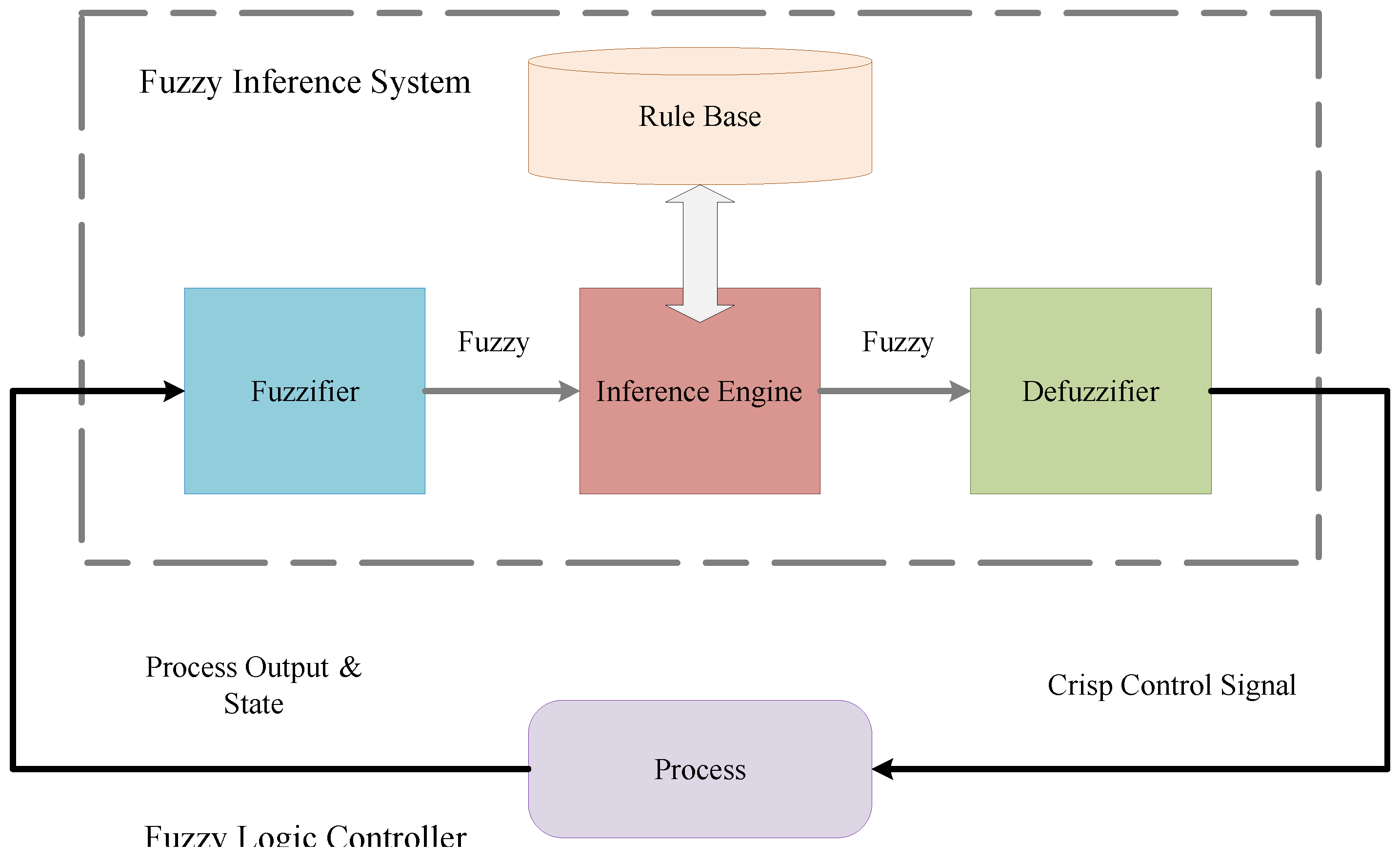
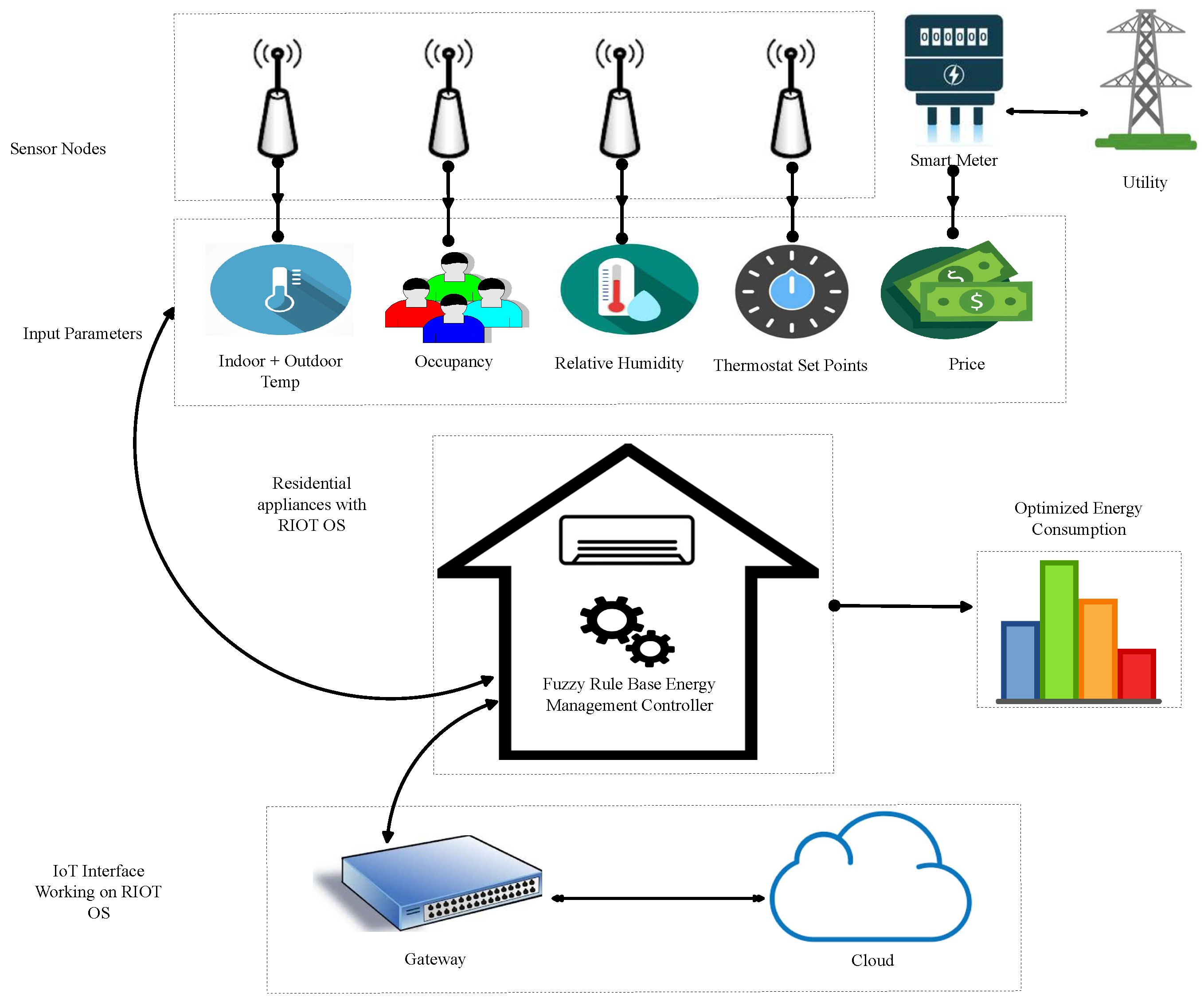
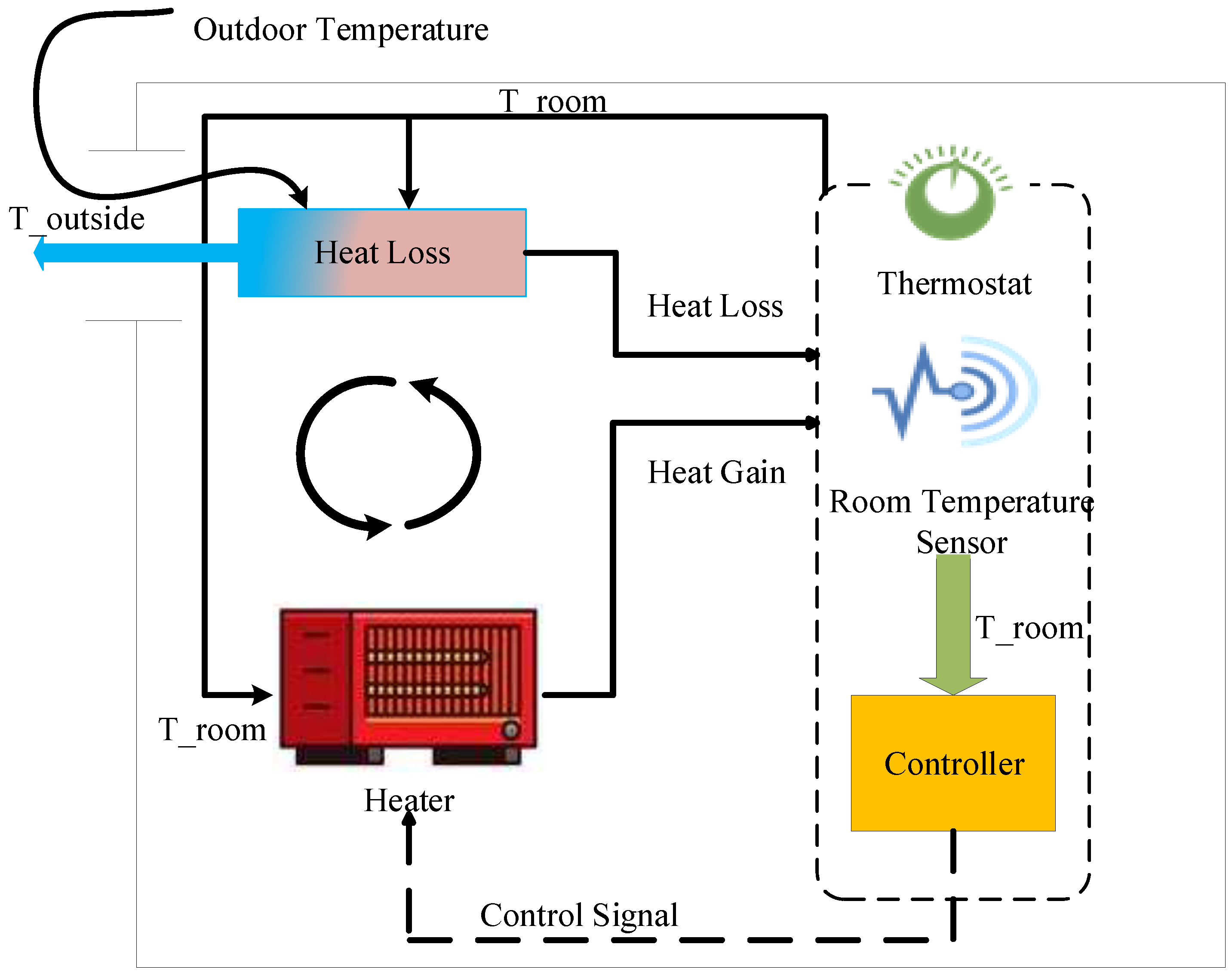
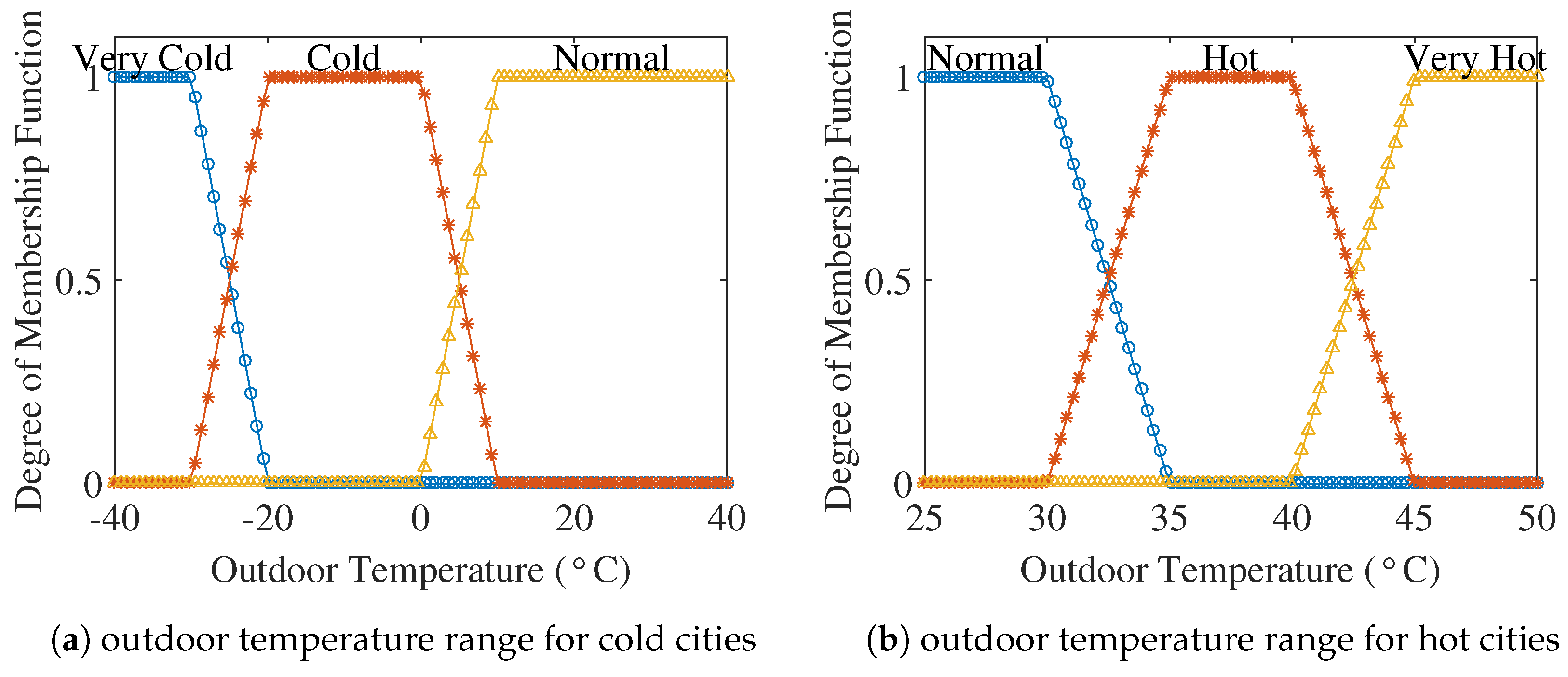
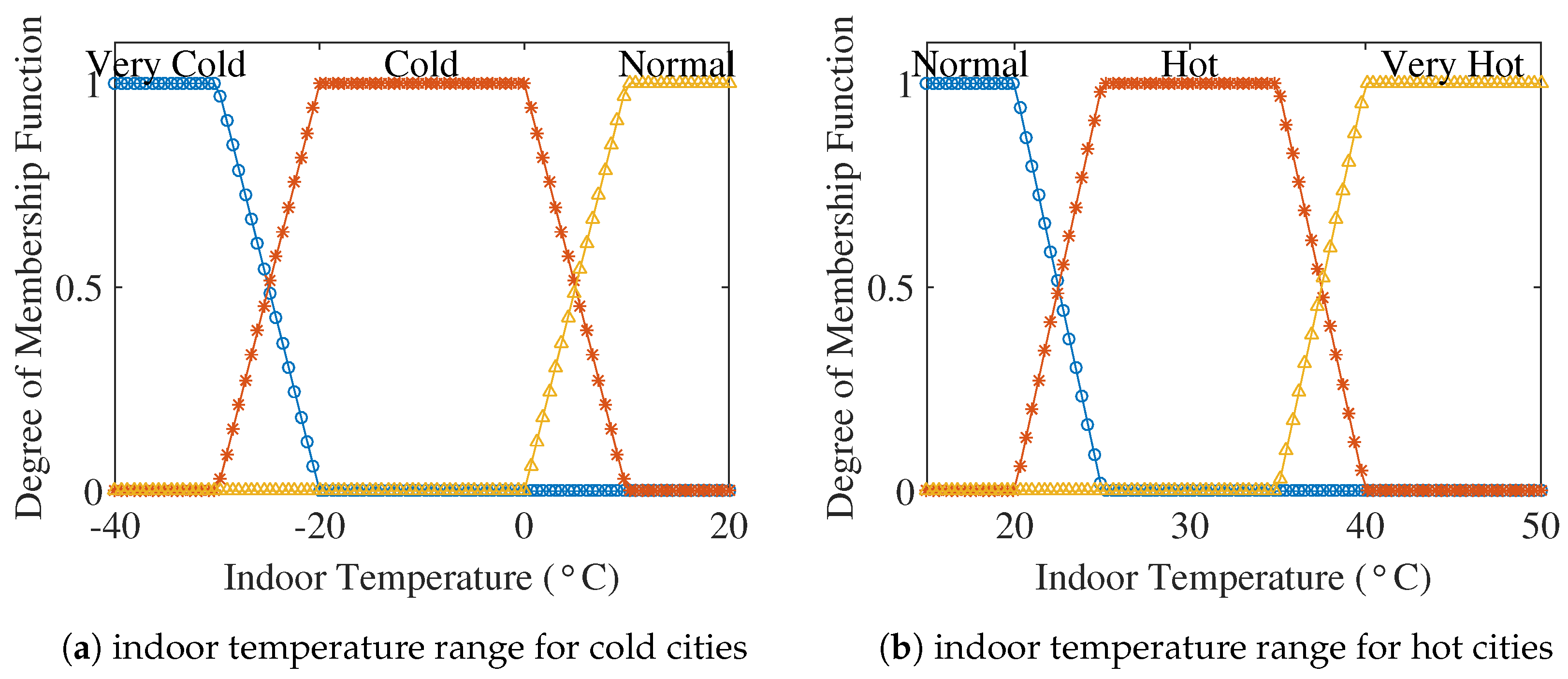
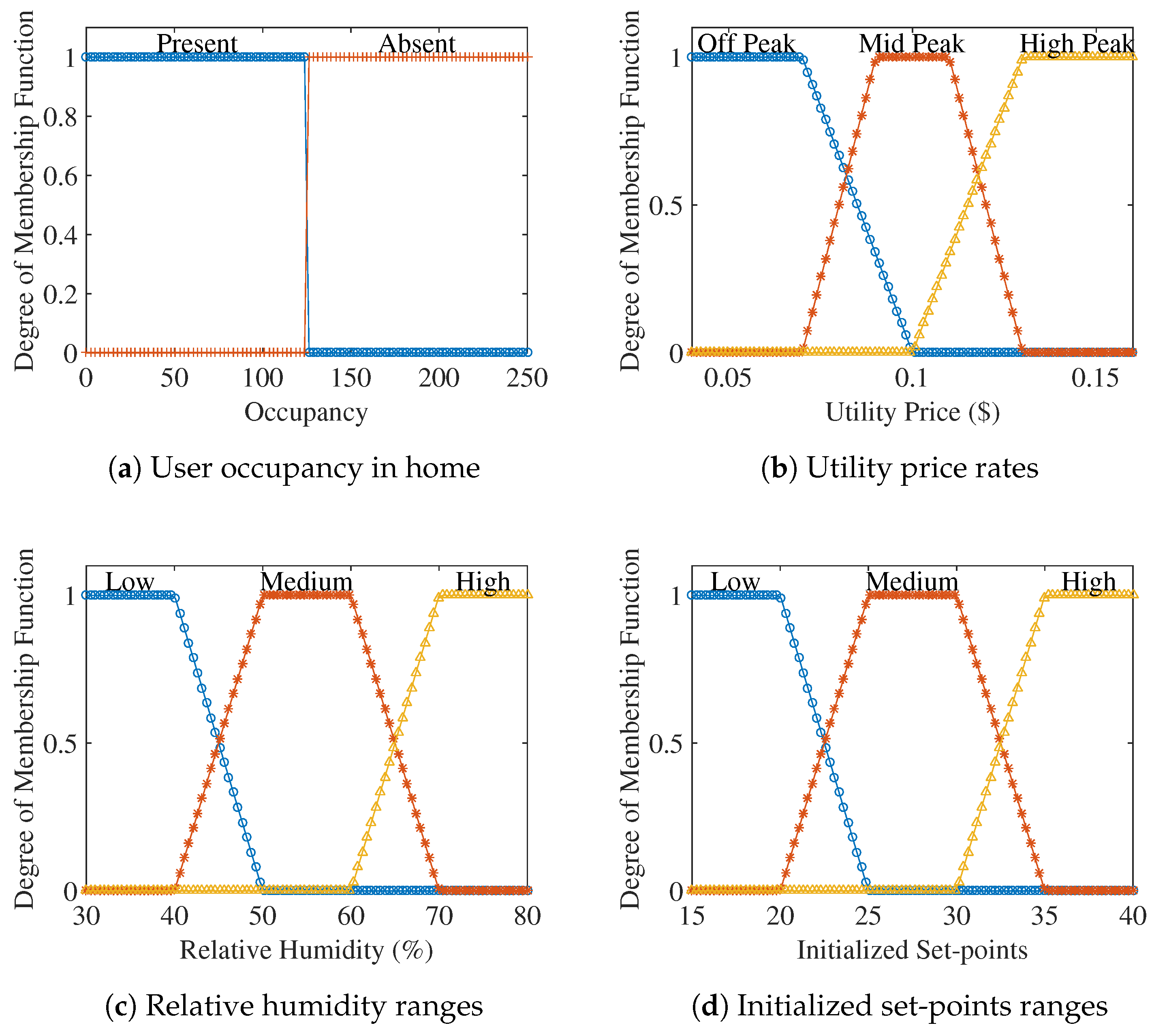
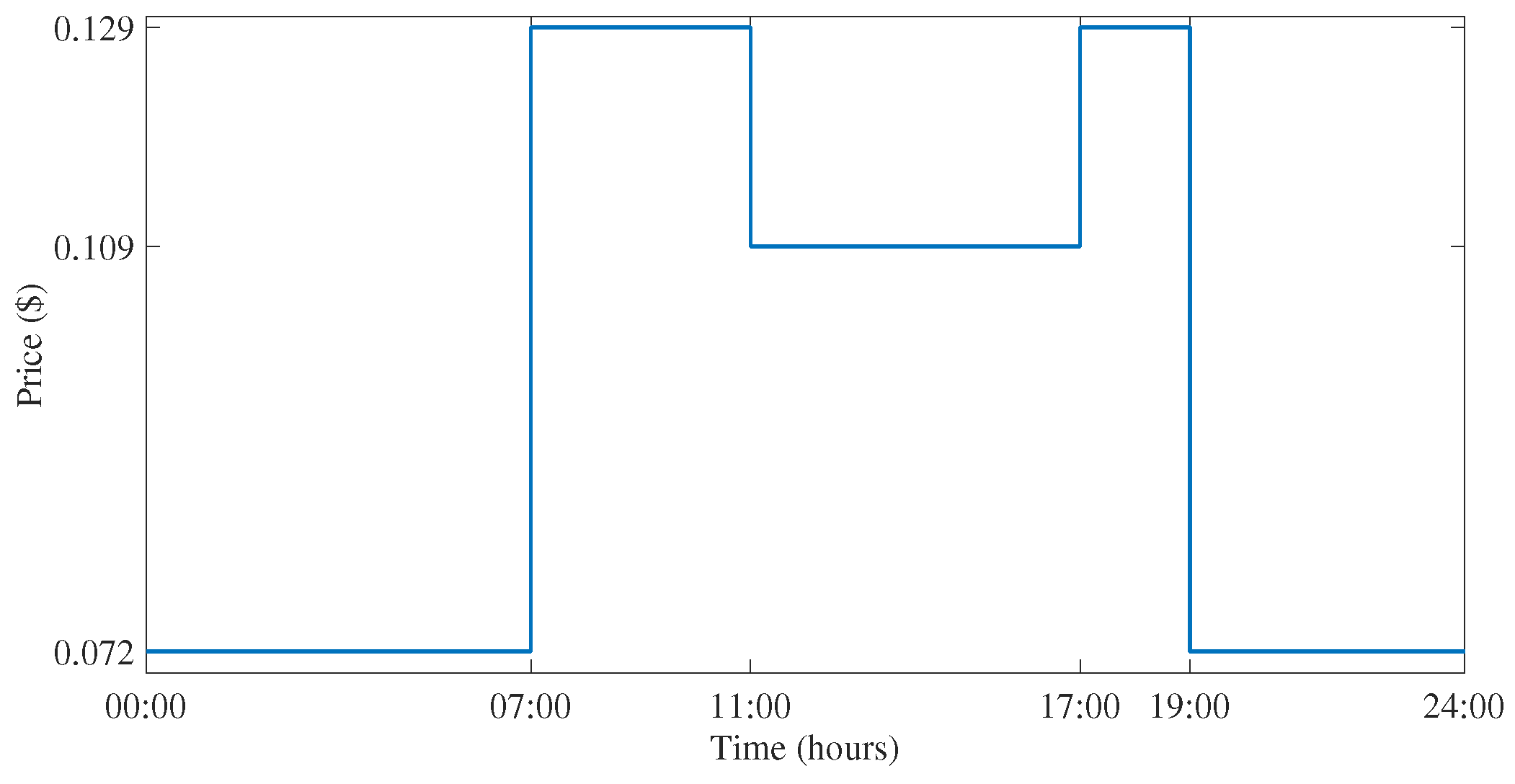
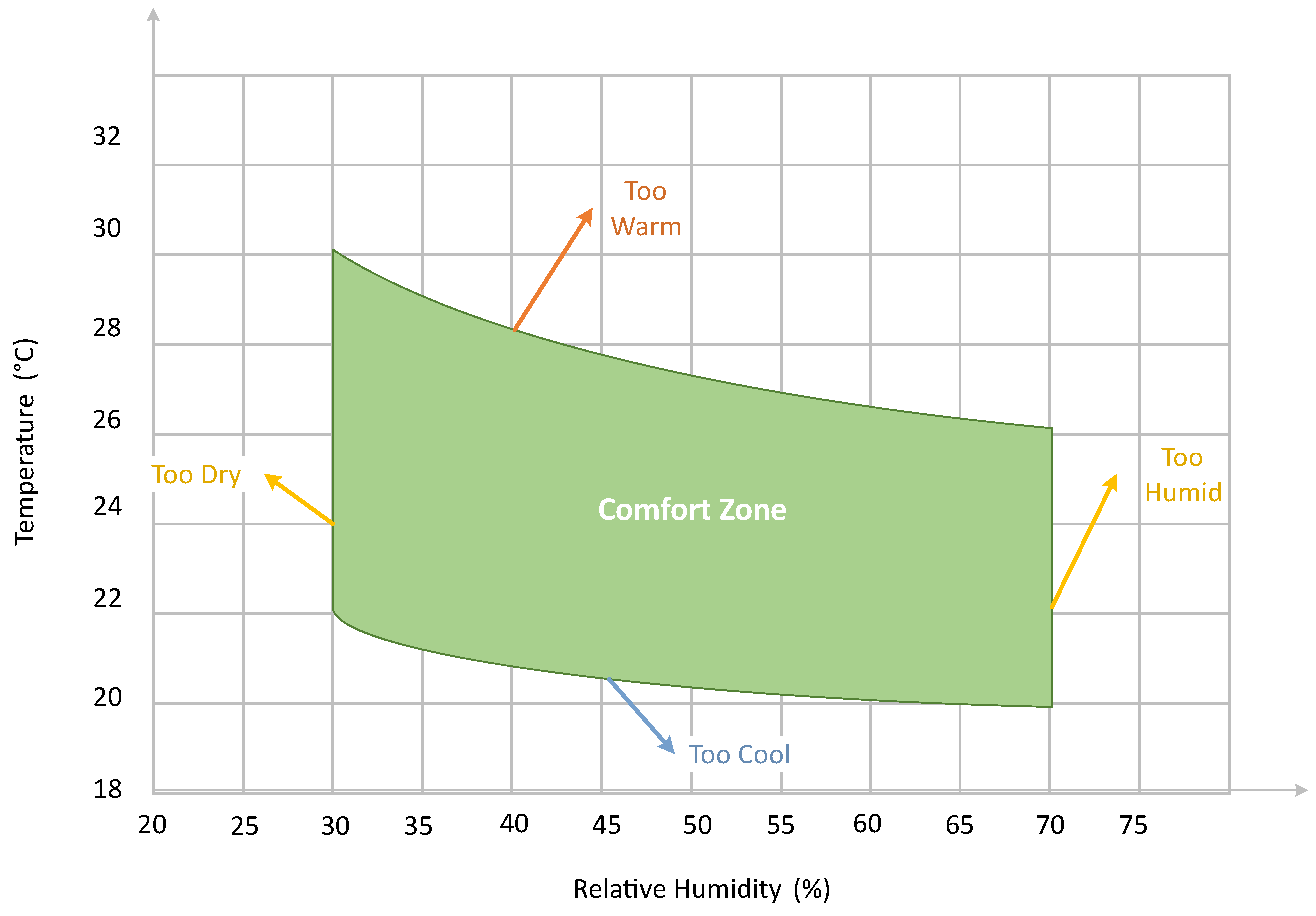
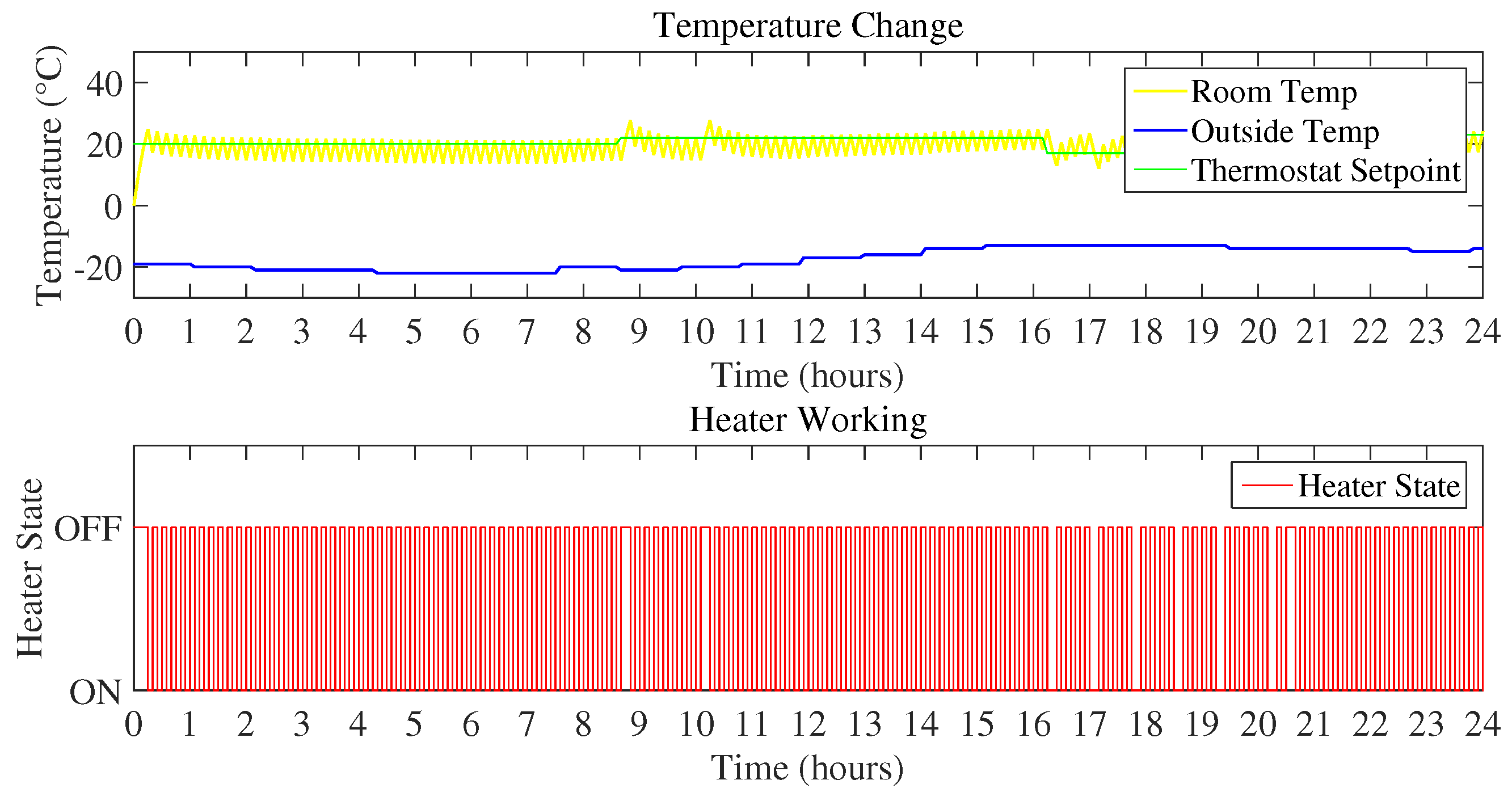
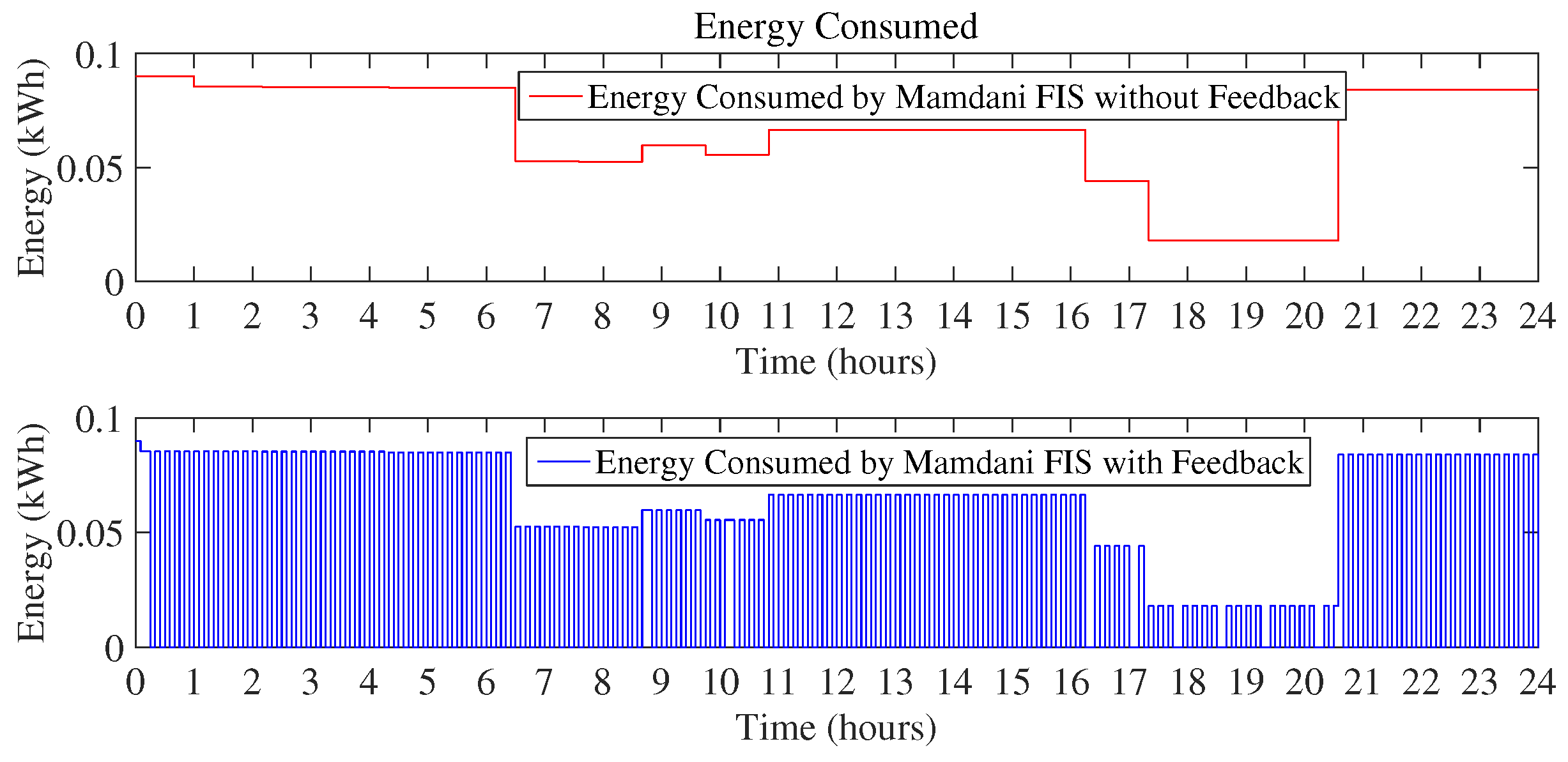
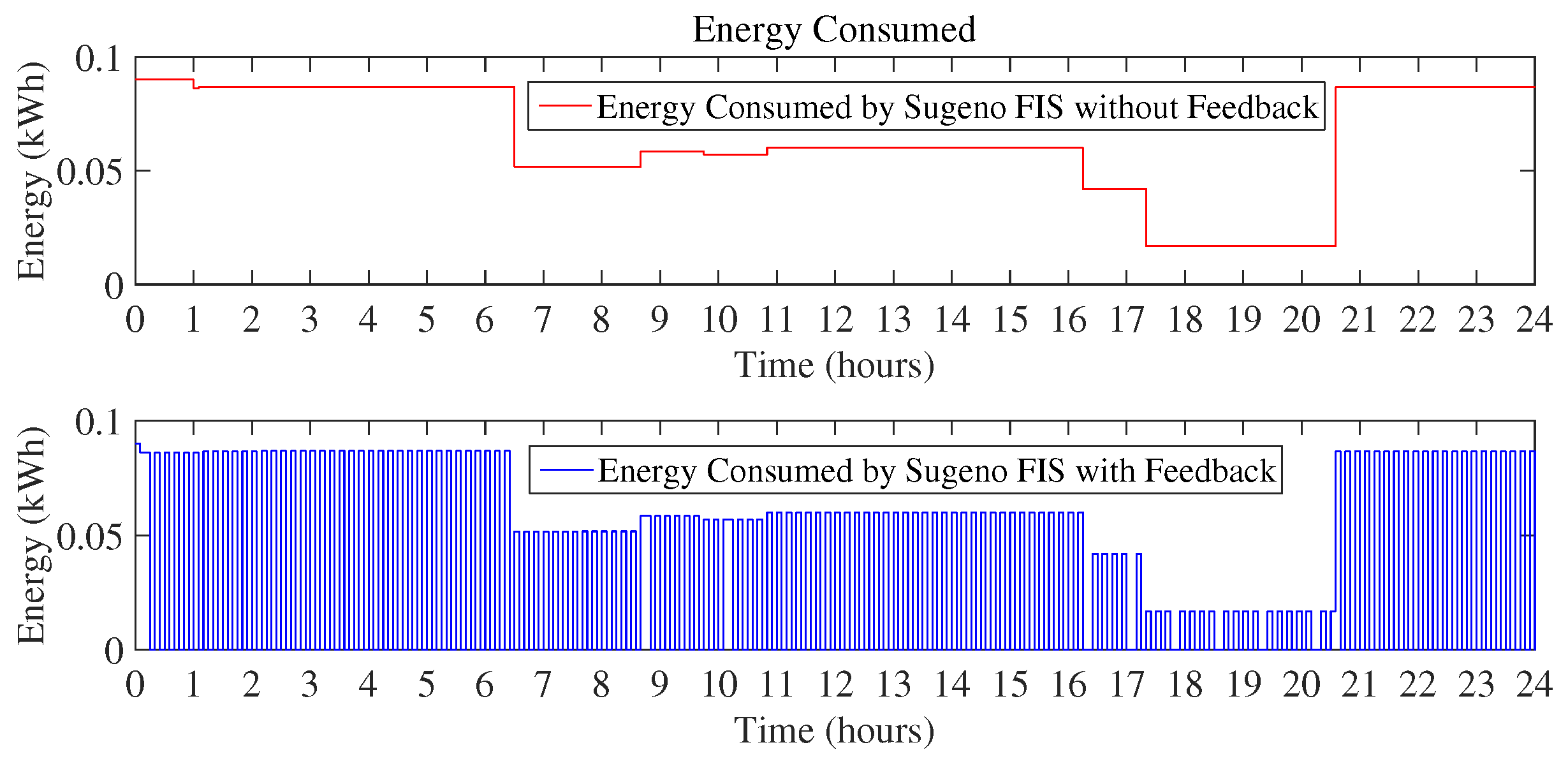
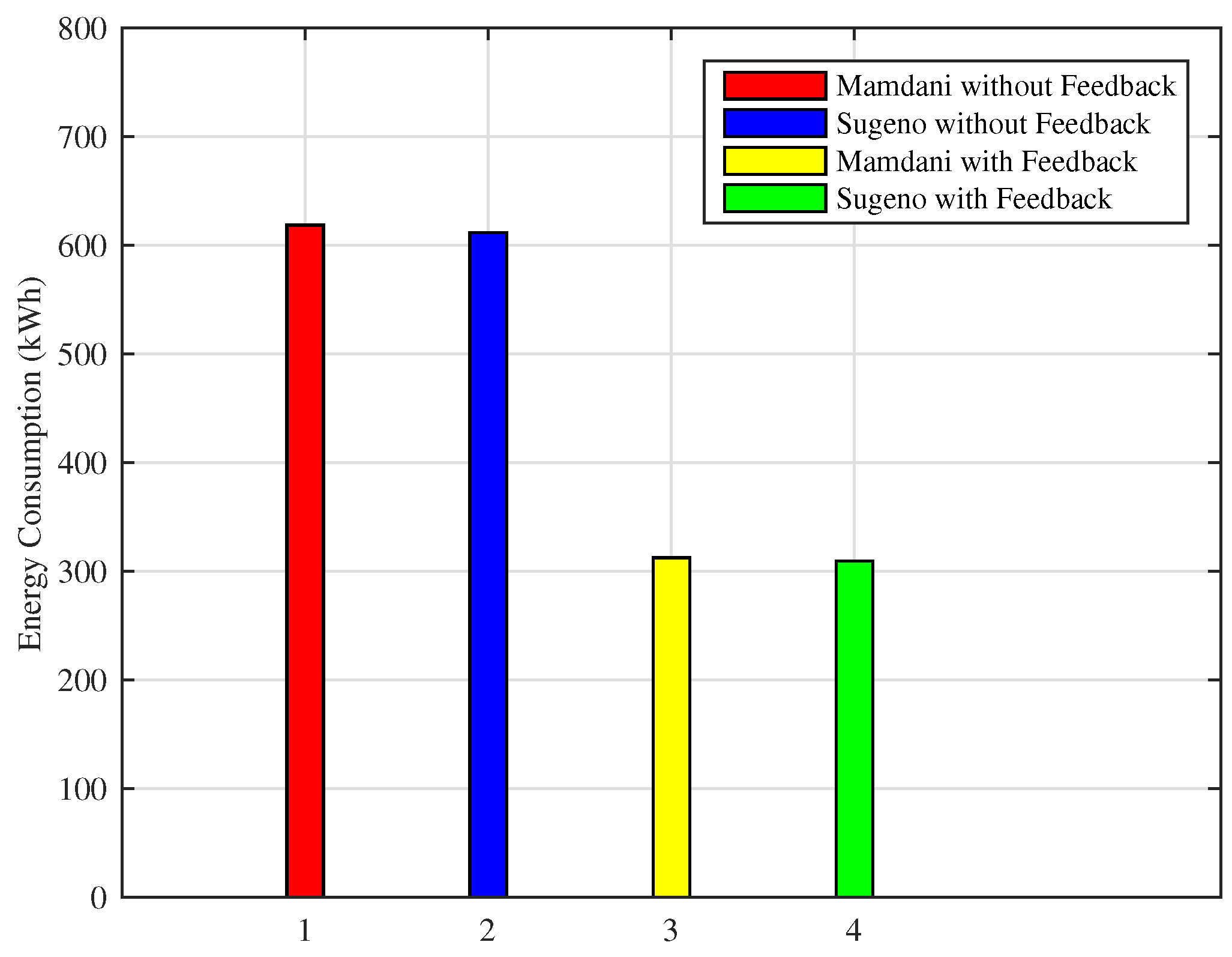
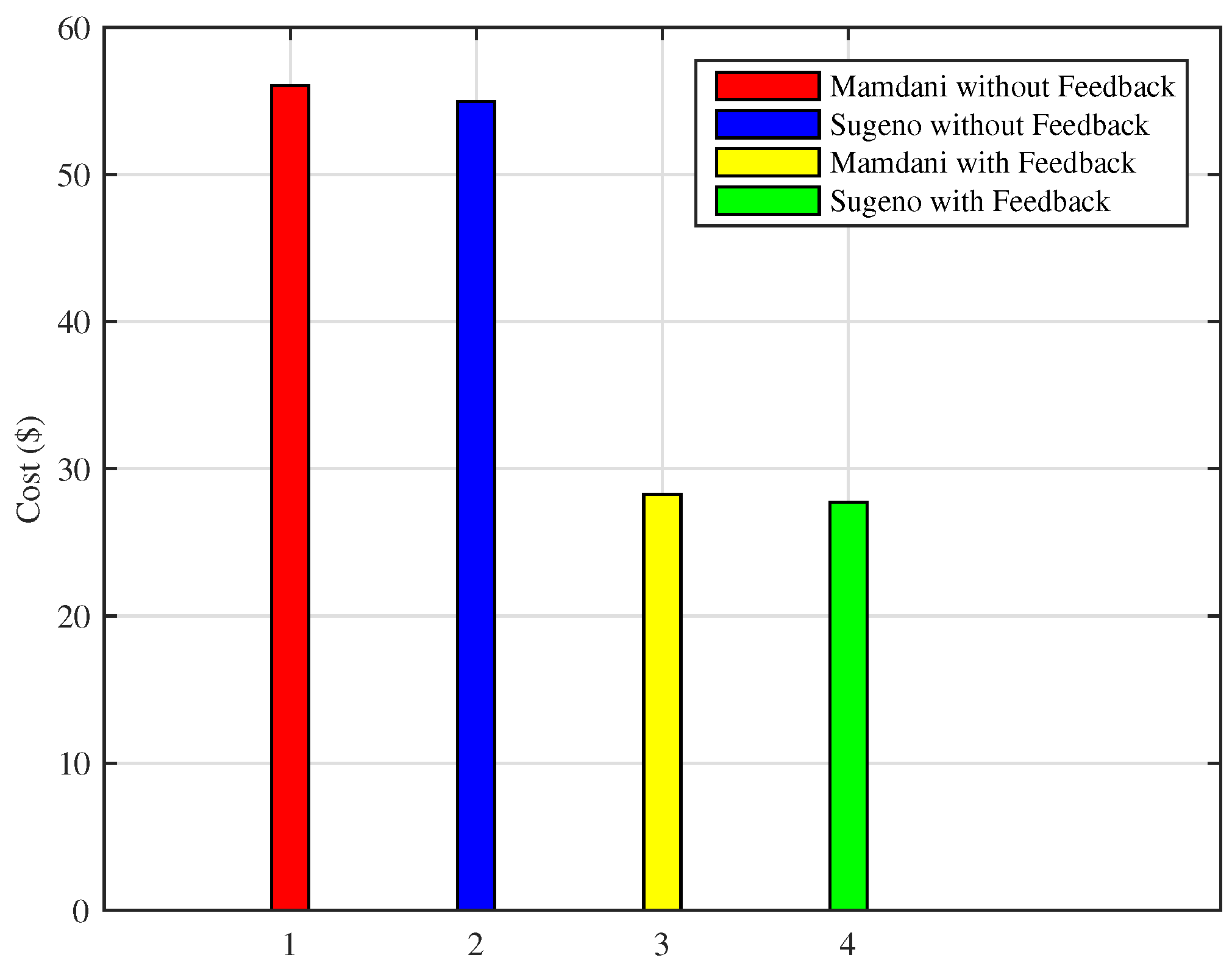
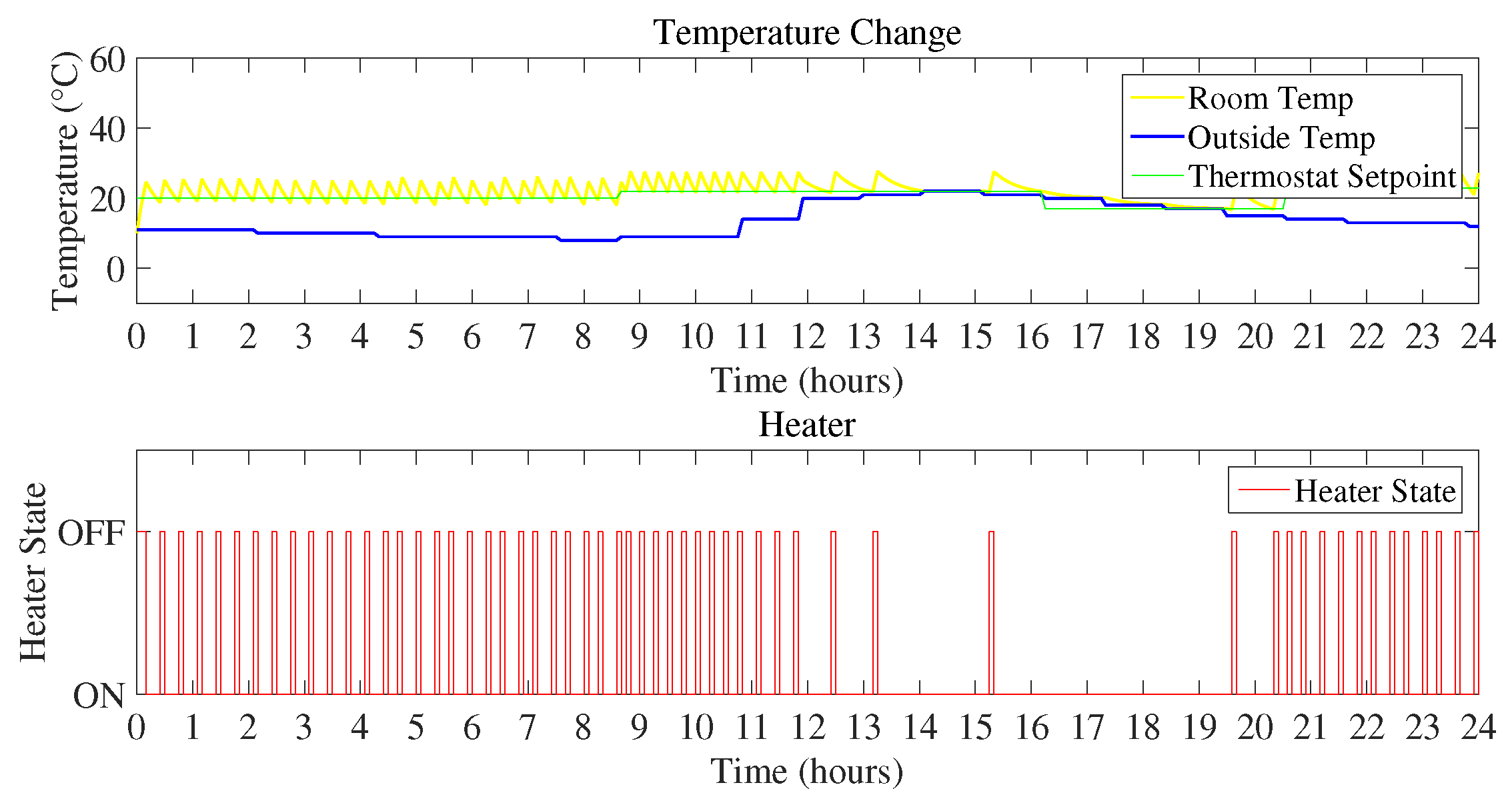

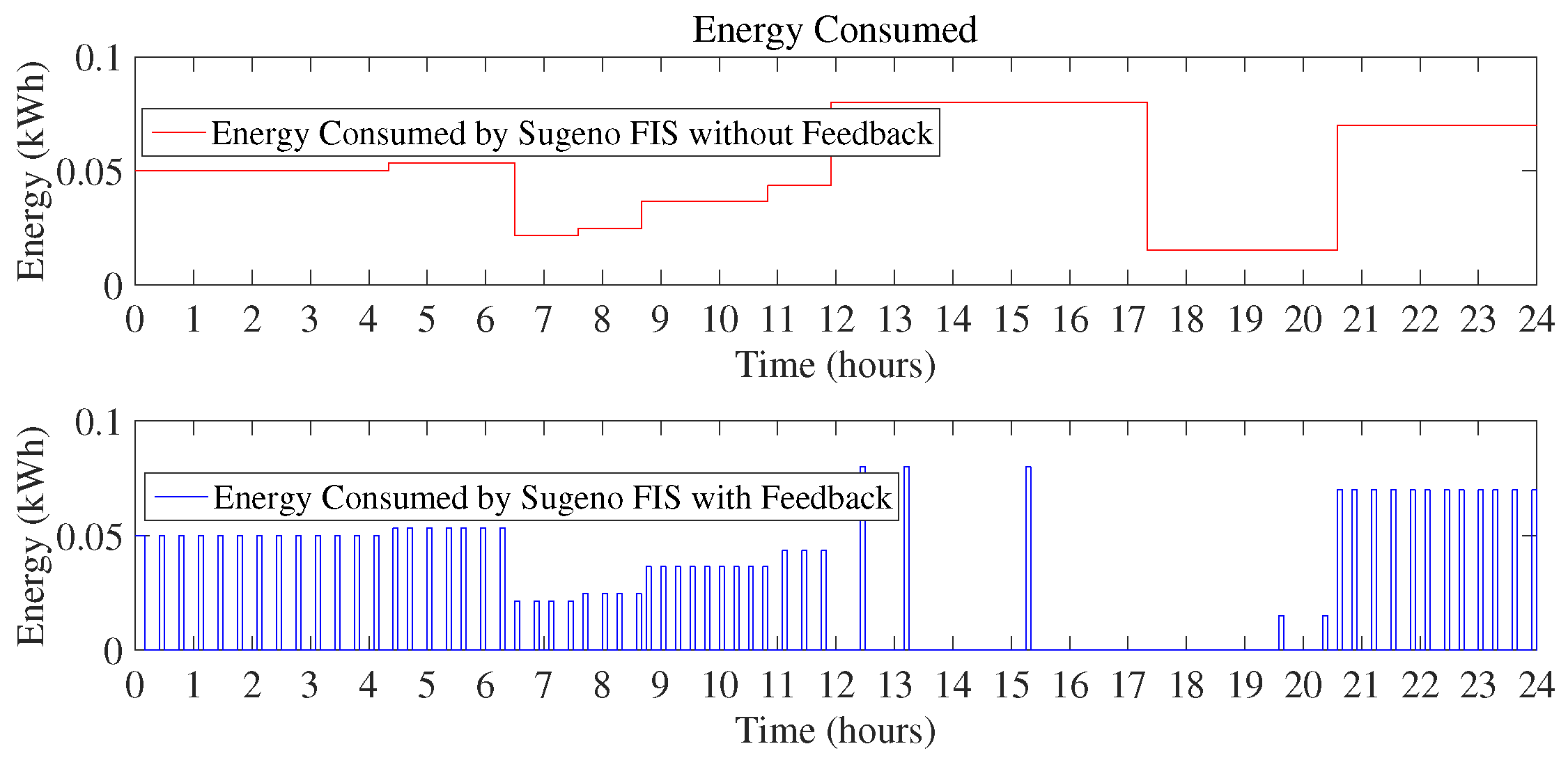
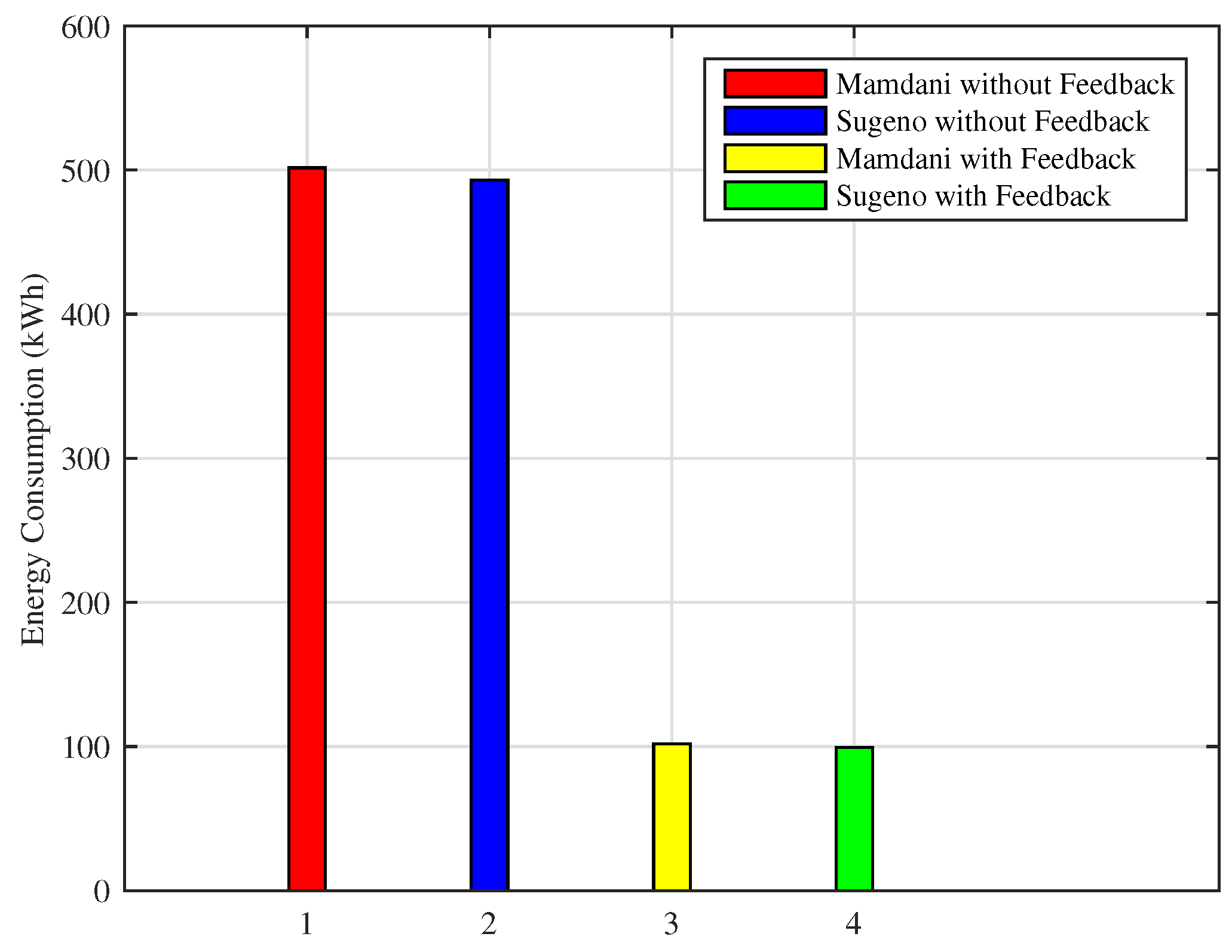
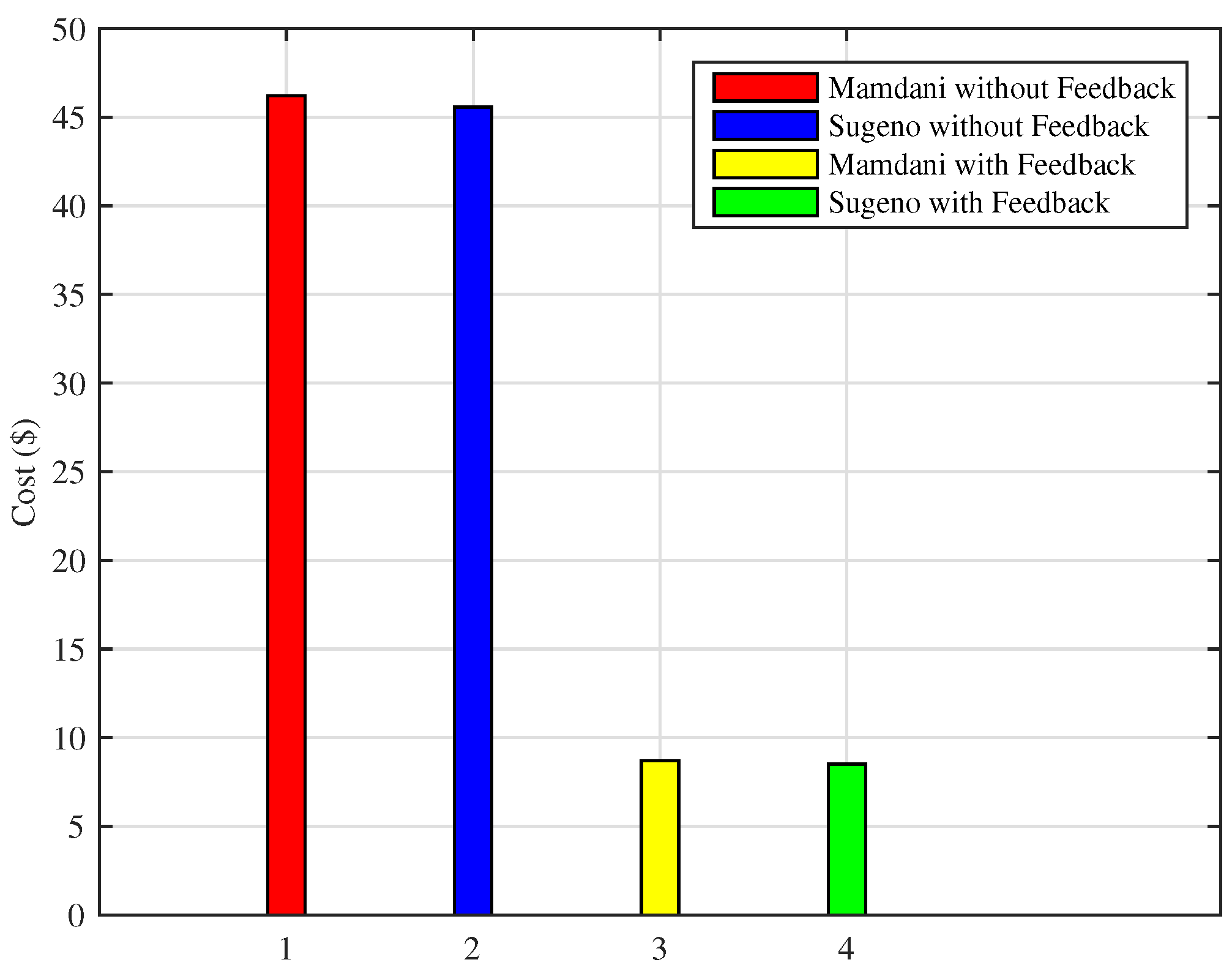
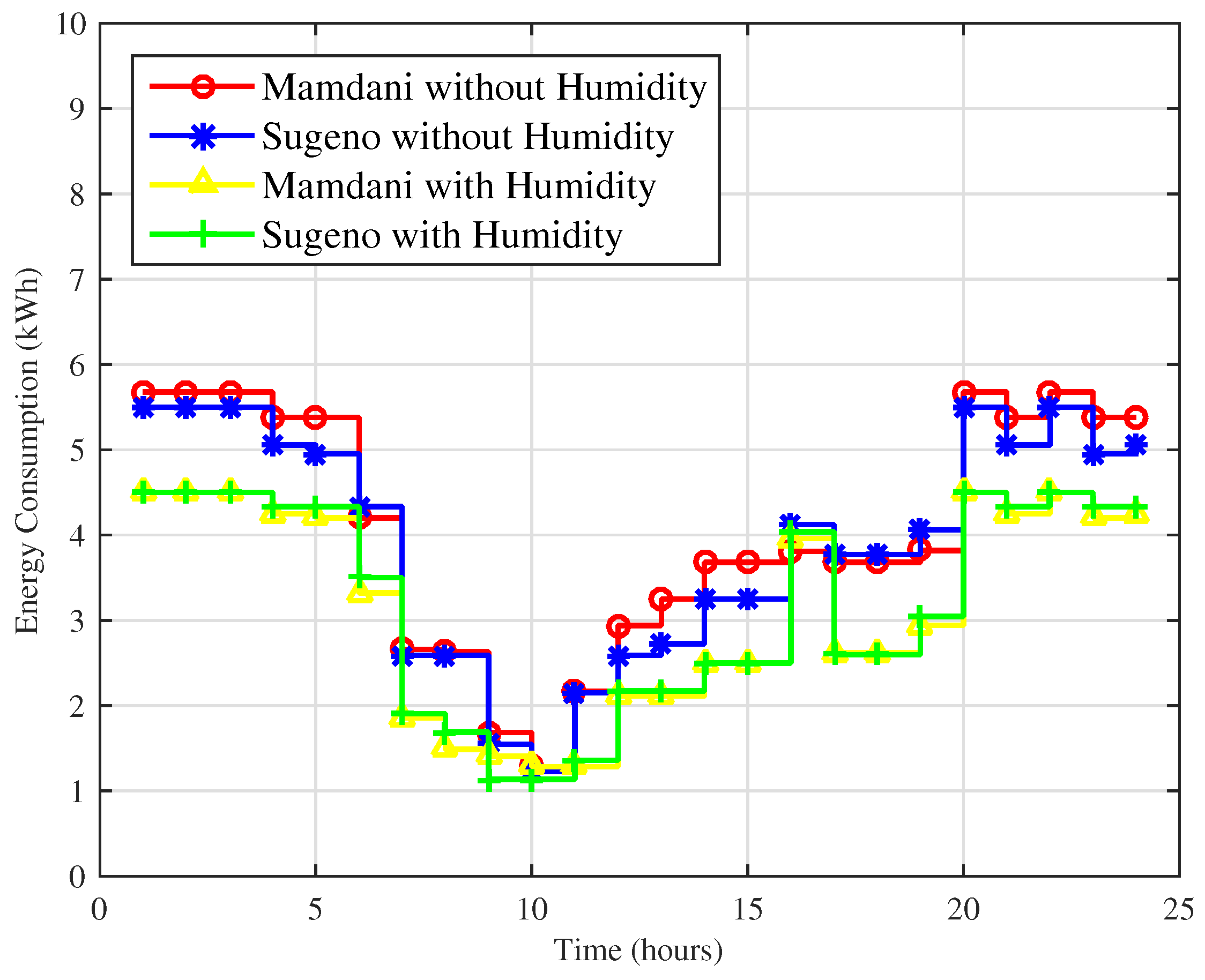
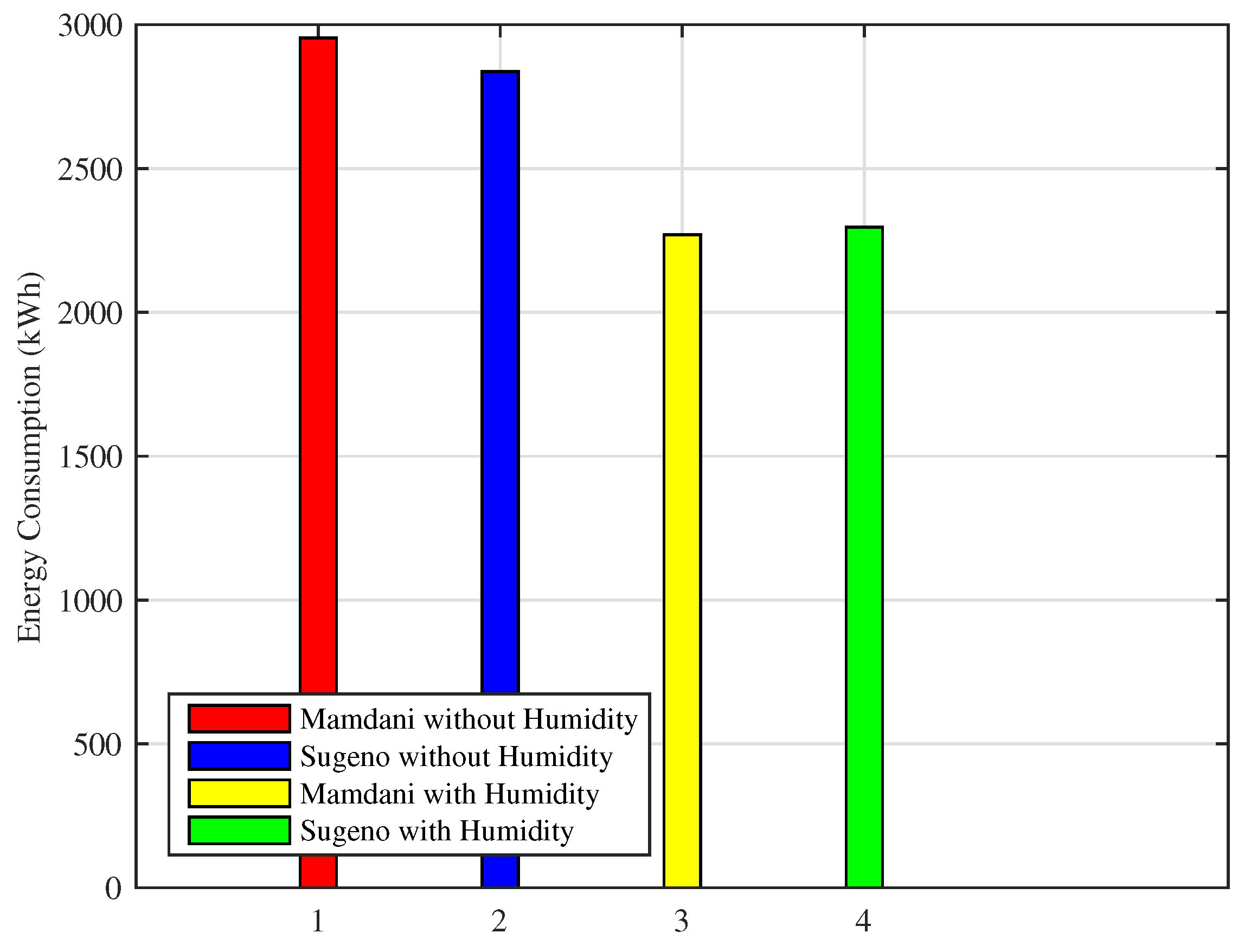
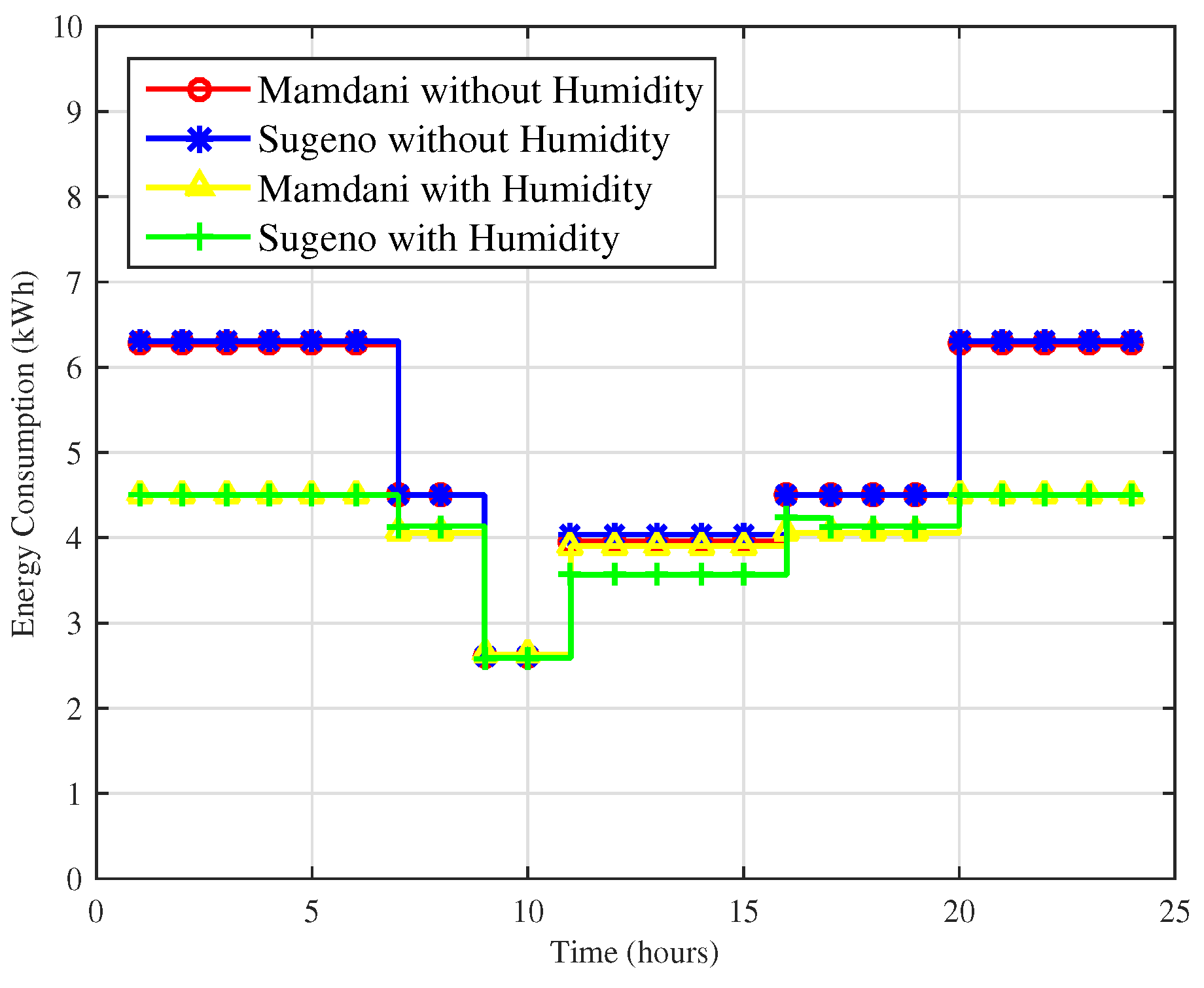
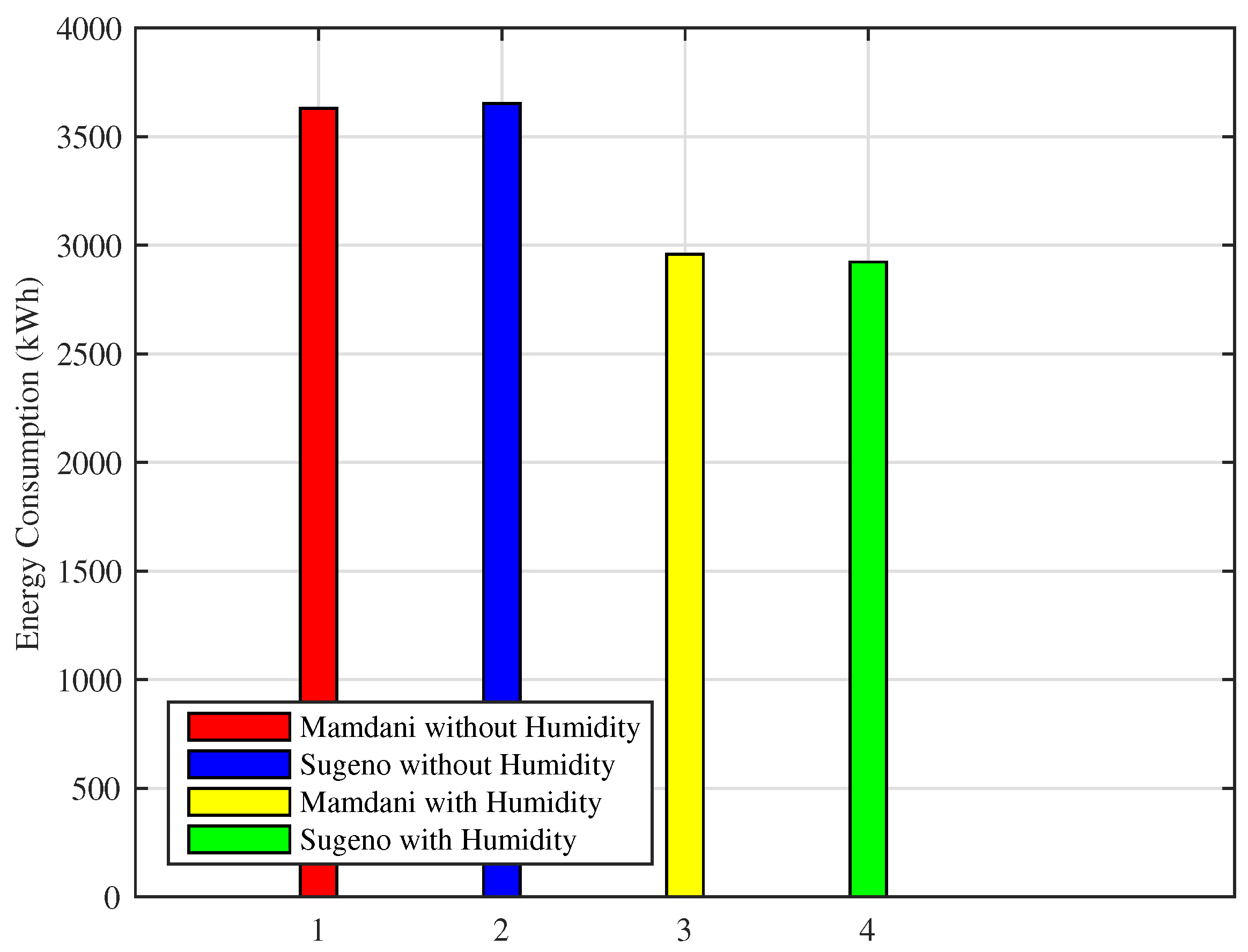
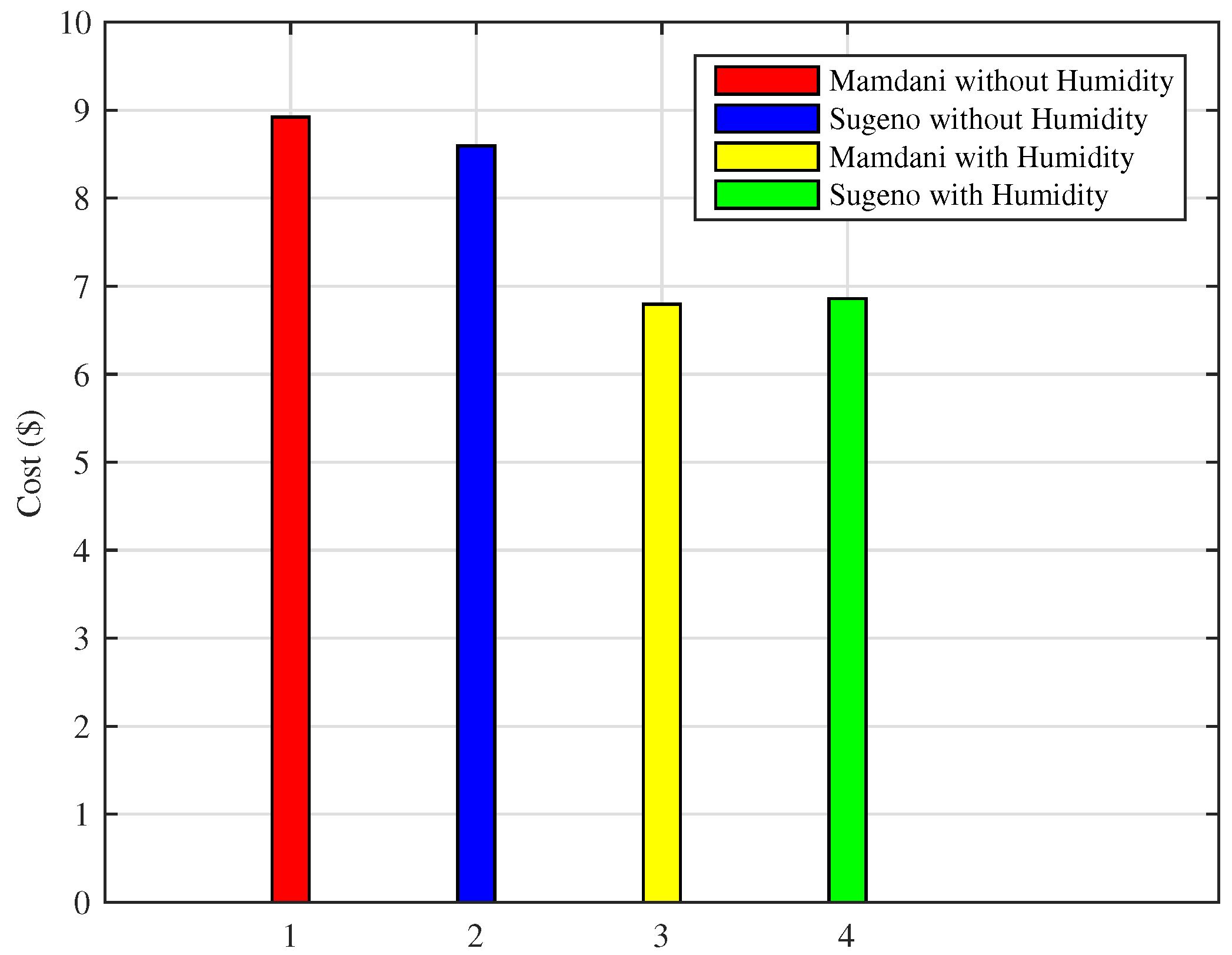
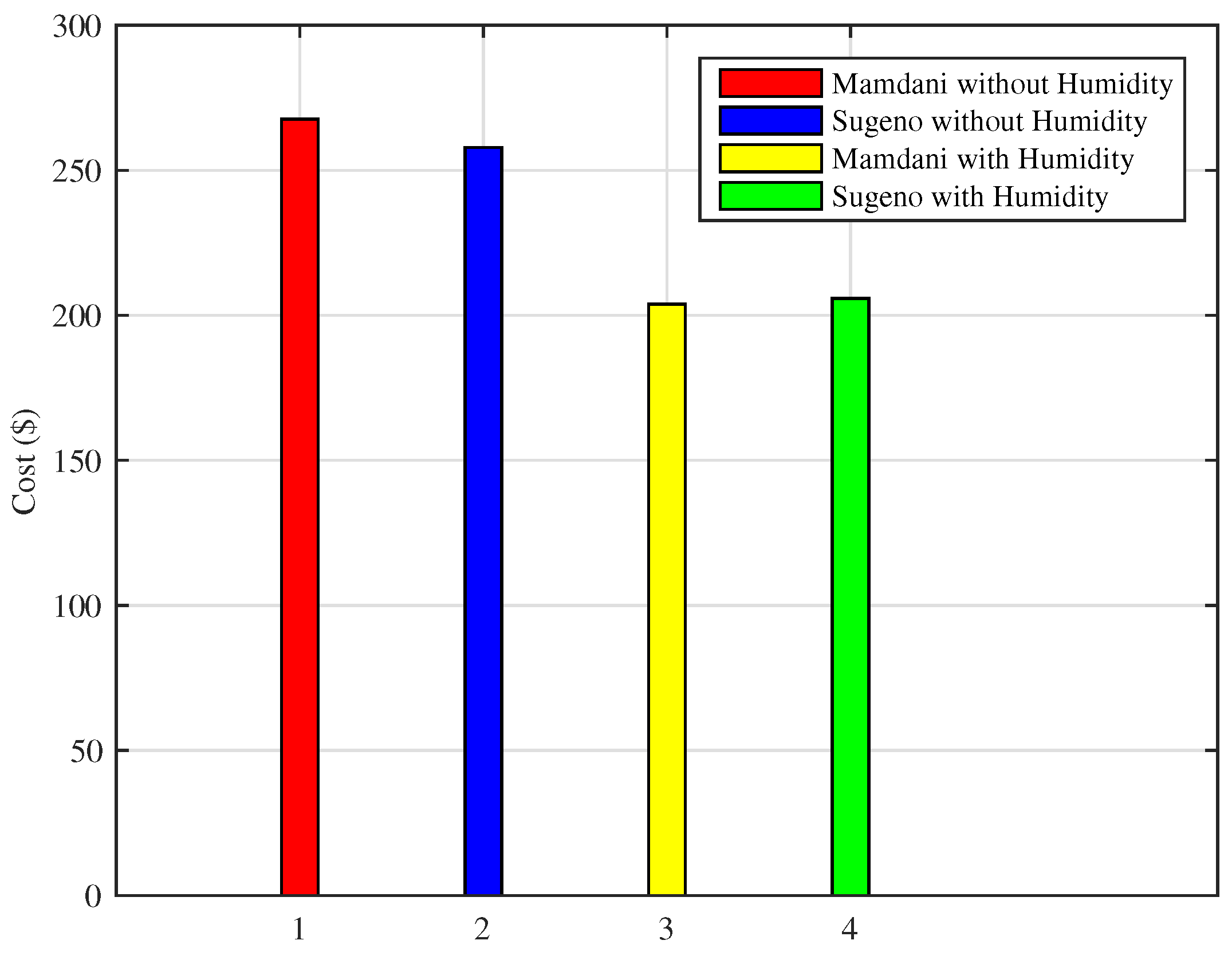
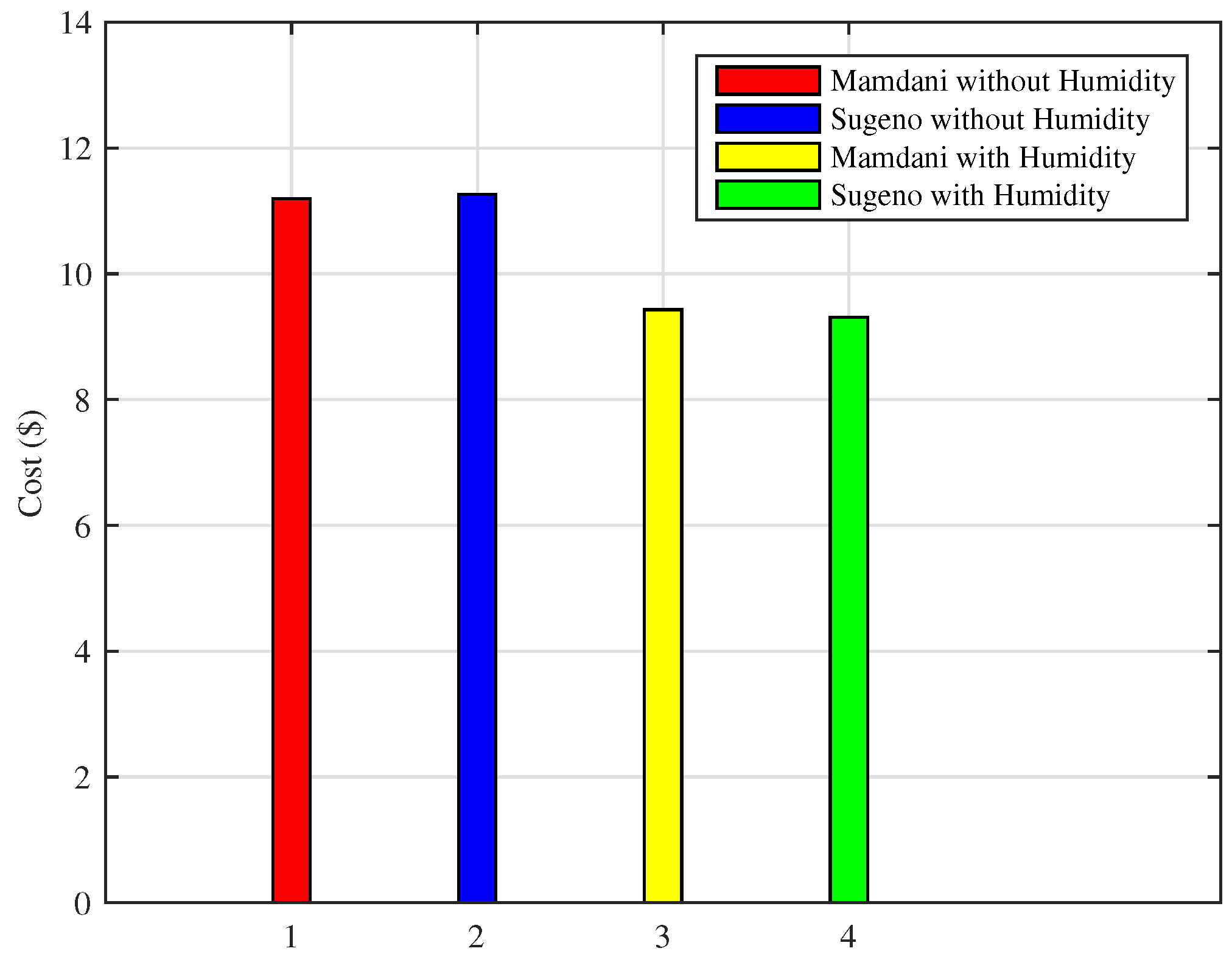
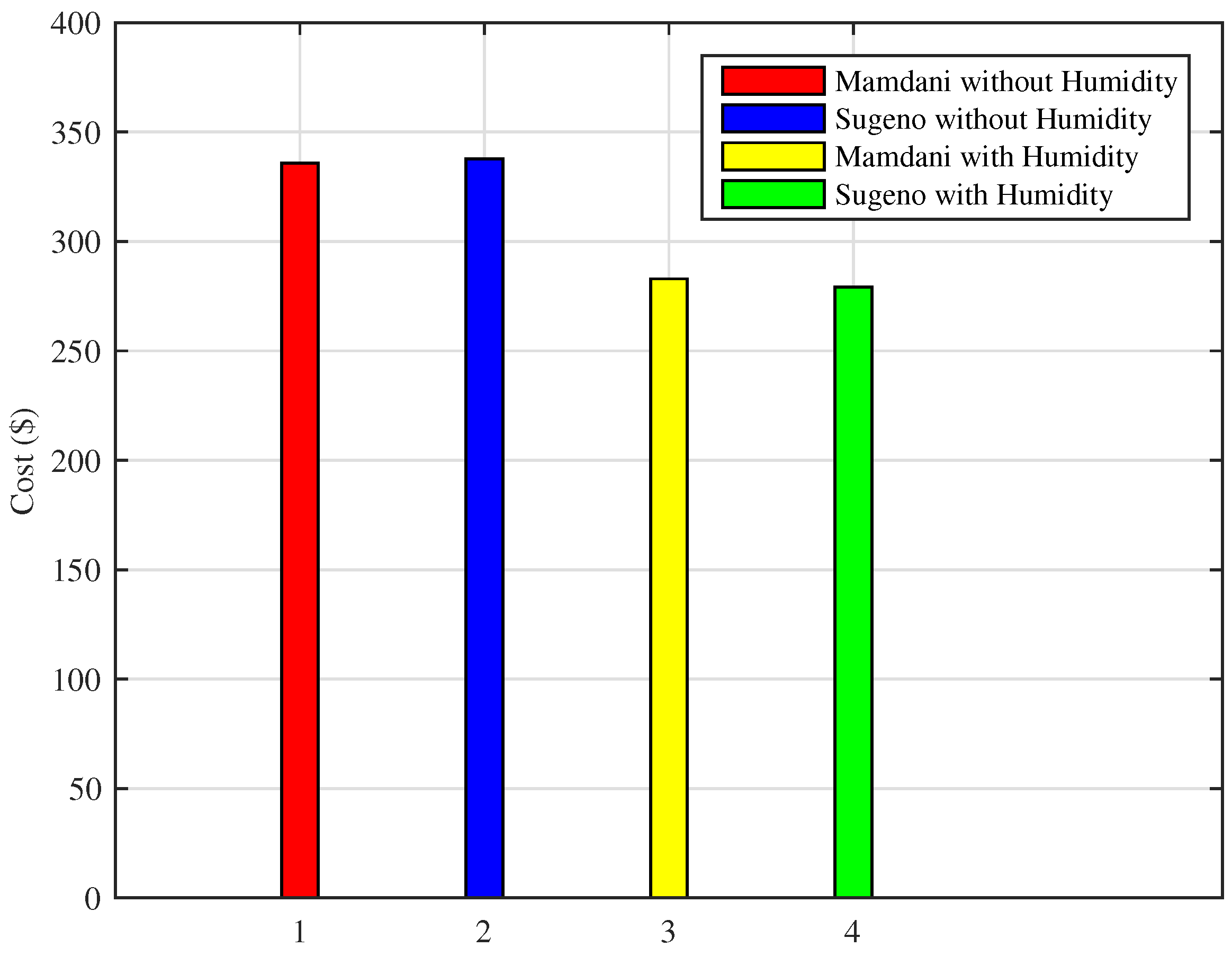
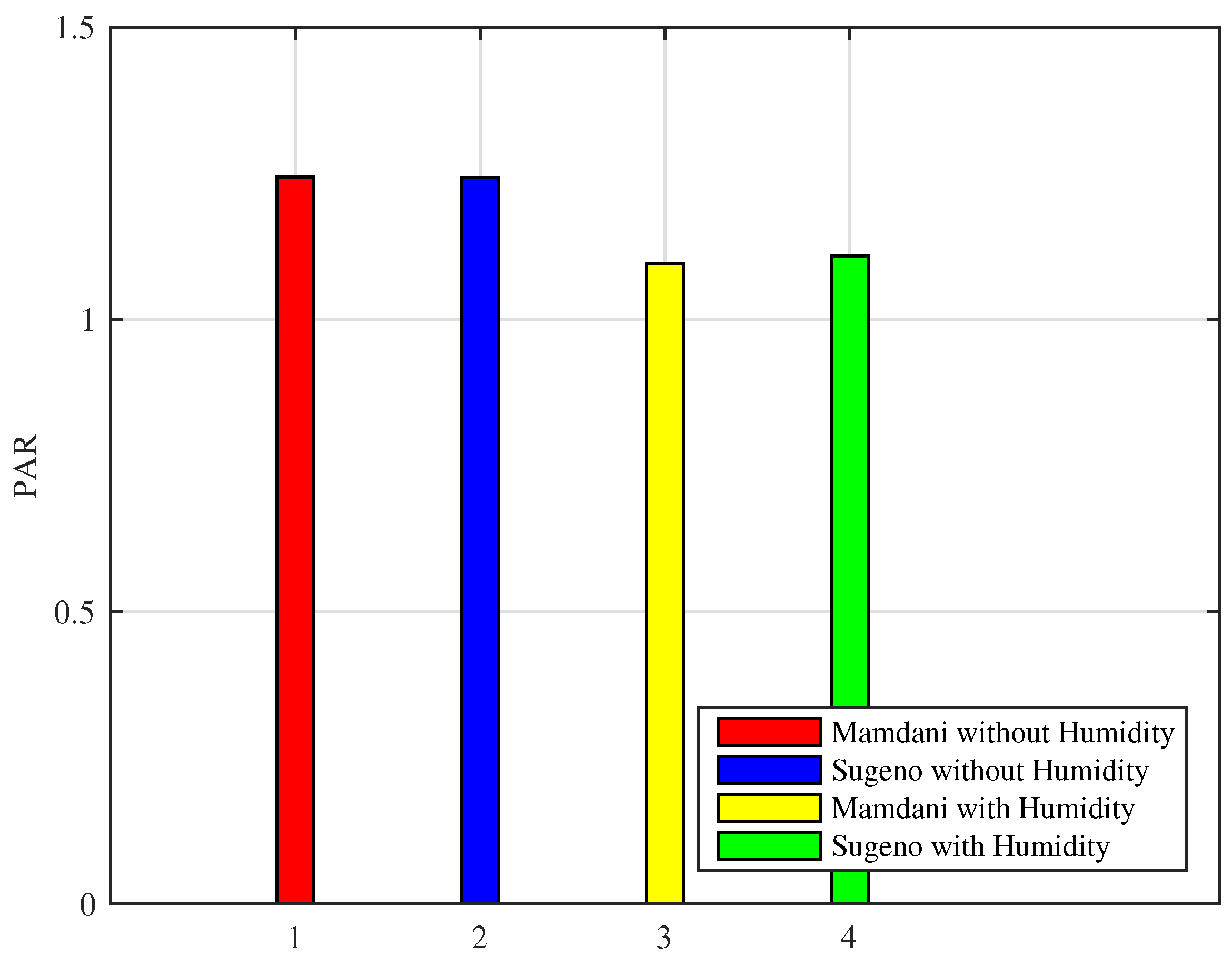
| Variables and Abbreviations | Description | Variables and Abbreviations | Description |
|---|---|---|---|
| FIS | Fuzzy Inference System | HEMS | Home Energy Management System |
| HVAC | Heating, Ventilation and Air Conditioning | PAR | Peak-to-Average Ratio |
| PCT | Programmable Communicating Thermostat | ToU | Time of Use |
| Indoor temperature fuzzy input parameter | Outdoor temperature fuzzy input parameter | ||
| Occupancy fuzzy input parameter | Electricity rate fuzzy input parameter | ||
| Thermostat set point fuzzy input parameter | Relative humidity fuzzy input parameter |
| Reference | Technique | The objective | A limitation |
|---|---|---|---|
| An efficient power scheduling scheme [30] | Hybrid of Knapsack Problem (K-WDO) | Minimization of the appliance waiting time and electricity cost. | Thermal comfort is ignored. |
| Air-conditioning system for proactive power demand response [32] | DSB and DFR | Cost and energy saving. | Use of synthetic dynamic prices and the system only works for offices. |
| The smart thermostat: using occupancy sensors [37] | Hidden Markov Model for occupancy based scheduling | Improved energy conservation. | Thermal comfort is sacrificed. Simulations are limited to only one type of HVAC. |
| Occupancy behavior-based model predictive control [39] | Occupancy based Model Predictive Control (MPC) | User comfort enhancement and energy consumption minimization. | High computational cost and increase the complexity of the system. |
| Hybrid Bacterial Foraging and Genetic Algorithm Optimization Techniques [40] | Hybrid of BFA and GA | Reduction in cost and PAR. | Thermal comfort is neglected. Only one pricing scheme is considered. |
| Scheduling Appliances with GA, TLBO, FA, OSR and Their Hybrids [41] | Hybrid of OSR with TLBO, FA, GA | Reduction in appliance waiting time, cost, PAR, and energy consumption. | Limited number of appliances. HVAC is not considered. |
| Dynamic demand response controller based on RTP [42] | Dynamic Demand Response Controller (DDRC) | Energy consumption minimization | Narrow range of the temperature band is considered. User preference is ignored. |
| A fuzzy logic system for demand-side load management [43] | Fuzzy logic rule based algorithm | Demand response participation. Minimization of the energy consumption. | User comfort is sacrificed. |
| An autonomous system via fuzzy logic [44] | Autonomous thermostat with Fuzzy Logic System | Energy conservation | Region-specific study. Only Mamdani FIS is considered. |
| An adaptive fuzzy logic system [17] | Adaptive Fuzzy Logic Model (AFLM) | Adapt the thermostat set-points according to user comfort. Energy consumption minimization. | The proposed technique only considered the cold regions. User comfort is heavily disturbed. |
| Worldwide adaptive thermostat using fuzzy inference system [28] | World-wide adaptive thermostat | Works for both cold and hot cities. Reduction in peak, cost and energy consumption. | User comfort is jeopardized. |
| i | |
| 1 | |
| 2 | |
| 3 | |
| 4 | |
| 5 | |
| 6 |
| #Rule | |||||||
|---|---|---|---|---|---|---|---|
| 1 | L | L | HP | A | L | L | VL |
| 2 | L | M | OP | P | L | L | M |
| 3 | L | H | MP | P | M | H | M |
| 4 | M | H | OP | A | H | H | H |
| 5 | M | L | MP | P | M | M | M |
| 6 | H | M | OP | A | L | M | M |
| 7 | H | H | OP | P | H | H | VH |
© 2018 by the authors. Licensee MDPI, Basel, Switzerland. This article is an open access article distributed under the terms and conditions of the Creative Commons Attribution (CC BY) license (http://creativecommons.org/licenses/by/4.0/).
Share and Cite
Ain, Q.-u.; Iqbal, S.; Khan, S.A.; Malik, A.W.; Ahmad, I.; Javaid, N. IoT Operating System Based Fuzzy Inference System for Home Energy Management System in Smart Buildings. Sensors 2018, 18, 2802. https://doi.org/10.3390/s18092802
Ain Q-u, Iqbal S, Khan SA, Malik AW, Ahmad I, Javaid N. IoT Operating System Based Fuzzy Inference System for Home Energy Management System in Smart Buildings. Sensors. 2018; 18(9):2802. https://doi.org/10.3390/s18092802
Chicago/Turabian StyleAin, Qurat-ul, Sohail Iqbal, Safdar Abbas Khan, Asad Waqar Malik, Iftikhar Ahmad, and Nadeem Javaid. 2018. "IoT Operating System Based Fuzzy Inference System for Home Energy Management System in Smart Buildings" Sensors 18, no. 9: 2802. https://doi.org/10.3390/s18092802
APA StyleAin, Q.-u., Iqbal, S., Khan, S. A., Malik, A. W., Ahmad, I., & Javaid, N. (2018). IoT Operating System Based Fuzzy Inference System for Home Energy Management System in Smart Buildings. Sensors, 18(9), 2802. https://doi.org/10.3390/s18092802






